Mirror Life: Life in Reverse

ChatGPT:
Mirror Life: The Science, the Promise, and the Peril
I.
Foundations: Chirality and Life’s Molecular Logic
- Chirality refers to “handedness” in molecules—structures that are non-superimposable on their mirror image, like left and right hands.
- Life on Earth is fundamentally chiral:
- Amino acids used in proteins are all L-enantiomers (left-handed).
- Sugars in DNA/RNA are all D-enantiomers (right-handed).
- This homochirality is deeply consistent and crucial:
- Ensures uniform folding of proteins and functioning of enzymes.
- Enables the double helix structure of DNA to form correctly.
- Permits reliable recognition and interaction between molecules in cells.
- Although the opposite enantiomers—D-amino acids and L-sugars—do exist in rare natural contexts (e.g., in bacterial walls or aging tissues), they are not used in core life processes like protein synthesis or genetic encoding.
II.
Mirror Life: A Speculative Frontier
- Mirror life refers to organisms composed entirely of mirror-image biomolecules:
- D-amino acids instead of L.
- L-sugars instead of D.
- Left-twisted DNA instead of the natural right-handed helix.
- These hypothetical beings would be biochemically analogous to Earth life—but inverted in chirality.
- The idea challenges the notion that life must always follow Earth’s handedness.
- It’s a concept born from advances in:
- Synthetic chemistry (creating mirror molecules in the lab).
- Synthetic biology (assembling artificial systems from scratch).
- Astrobiology (considering alternative life forms elsewhere in the universe).
III.
Origins and Rationale for Exploring Mirror Life
- Why study mirror life?
- To understand how life might evolve with different chemical constraints.
- To explore why life chose one chirality over another—was it random or inevitable?
- To investigate biosafety and resilience: Could mirror biomolecules resist degradation, aging, or disease?
- To prepare for the detection of alien life, which might have the opposite handedness.
- To explore therapeutic applications, such as mirror peptides or mirror-DNA as drugs resistant to degradation.
- Louis Pasteur’s 19th-century discovery of molecular chirality laid the groundwork.
- He noticed that tartaric acid crystals separated into two mirror forms.
- Only one form rotated light and interacted with living organisms.
IV.
Scientific Progress Toward Mirror Systems
- Recent advances have produced:
- Mirror nucleic acids: L-DNA and L-RNA.
- Mirror proteins built from D-amino acids.
- Enzymes that can read and copy mirror-DNA (in very controlled systems).
- However, no self-replicating mirror organism yet exists.
- Scientists have not yet built a full mirror ribosome—the key to translating genetic code into proteins.
- The creation of autonomous mirror bacteria is still theoretical—but many believe it could be possible within a decade.
V.
The Promise: Why Mirror Biomolecules Matter
- Therapeutics and Diagnostics:
- Mirror-DNA and mirror-peptides are resistant to degradation by natural enzymes.
- Could be used to make long-lasting drugs, biosensors, or diagnostic tools.
- Already being explored in cancer therapy, gene regulation, and targeted imaging.
- Synthetic Biology:
- Mirror systems provide a clean slate for creating life-like systems without interfering with natural life.
- Could be used to build biological computers or molecular factories in confined settings.
- Astrobiology and Origins Research:
- Mirror life may help explain why terrestrial life is homochiral.
- If mirror life evolved independently elsewhere, it would confirm that life can emerge under radically different rules.
VI.
The Peril: Risks of Constructing Mirror Life
A.
Immune System Blindness
- Earth’s immune systems are highly chiral-specific.
- Antibodies, enzymes, and T-cell receptors are shaped to detect L-amino acid proteins and D-sugar-based DNA.
- A mirror organism would be:
- Invisible to the immune system.
- Resistant to degradation by natural enzymes.
- If a mirror microbe were released, it might infect and grow in hosts without triggering any immune defense.
B.
Antibiotic Resistance
- All known antibiotics and antimicrobial peptides are tailored to natural chirality.
- Mirror bacteria would be:
- Totally resistant to existing drugs.
- Unaffected by natural bacteriophages or microbial competition.
- This creates a situation where no known biological countermeasure would be effective.
C.
Ecological Invasion
- A mirror organism wouldn’t face natural predators, pathogens, or immune responses.
- It could:
- Thrive in niches where Earth organisms can’t compete.
- Exploit achiral or non-specific nutrients like carbon dioxide or phosphate.
- Potentially outcompete natural microbes if it gained replication competence.
D.
Biosecurity and Dual-Use Risks
- Mirror life research, especially for military or covert applications, has dual-use potential:
- Could be used to create undetectable biological agents.
- Would be immune to most current detection and treatment methods.
- The risk is magnified by:
- Increasing ease of DNA synthesis and protein engineering.
- Lack of regulatory frameworks specific to mirror systems.
VII.
The Precaution: What Scientists Are Calling For
In response to these concerns, leading synthetic biologists, immunologists, and ethicists (including authors of the Science article) recommend:
- Immediate moratorium on the creation of replicating mirror organisms.
- Especially those with functional mirror ribosomes and mirror genomes.
- Encouraging research on non-replicating mirror molecules:
- For medical and diagnostic applications.
- As they pose low risk and high benefit.
- Regulatory oversight:
- Establish monitoring of mirror-oligonucleotide synthesis.
- Classify mirror genome assembly and mirror ribosome engineering as high-security research areas.
- Develop global standards under the WHO or other international science governance bodies.
- Risk modeling and testing:
- Support studies on how mirror organisms might interact with Earth life.
- Develop mirror phages or enzymes as countermeasures, in case containment fails.
VIII.
Broader Reflections: What Mirror Life Teaches Us
- The very possibility of mirror life challenges our assumptions about biology’s inevitability.
- It pushes us to ask:
- Is life on Earth a frozen accident?
- Would alien life forms be fundamentally different—or similar with reversed handedness?
- Can we build alternative life responsibly, without repeating mistakes from other disruptive technologies?
- Mirror life is not just a scientific project—it is an ethical and existential test of our wisdom and foresight.
IX.
Conclusion: A Double-Edged Breakthrough
- Mirror life is one of the most intriguing and potentially transformative ideas in modern biology.
- It holds real promise in medicine, diagnostics, and origins research.
- But creating autonomous mirror organisms without clear safeguards is a risk with potentially global consequences.
Like a mirror, it reflects back at us not only life’s structural choices—but our own moral clarity.
Moonlight, Memory, and Music: Why Barcarolle Moves Us All
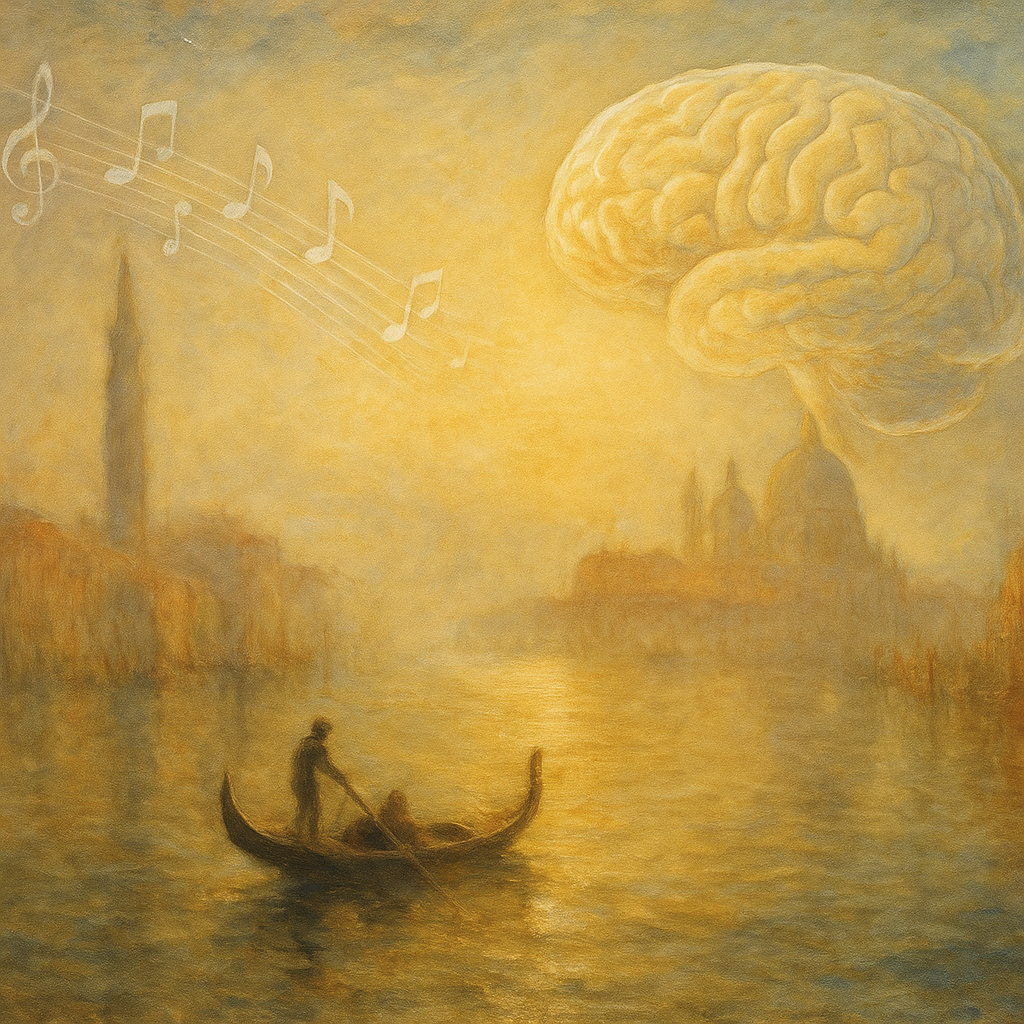
In a documentary about this Turner’s painting of Venice, Bacarolla is the background music, it really enhances the appreciation of the painting, explains from the perspective of neuroscience.
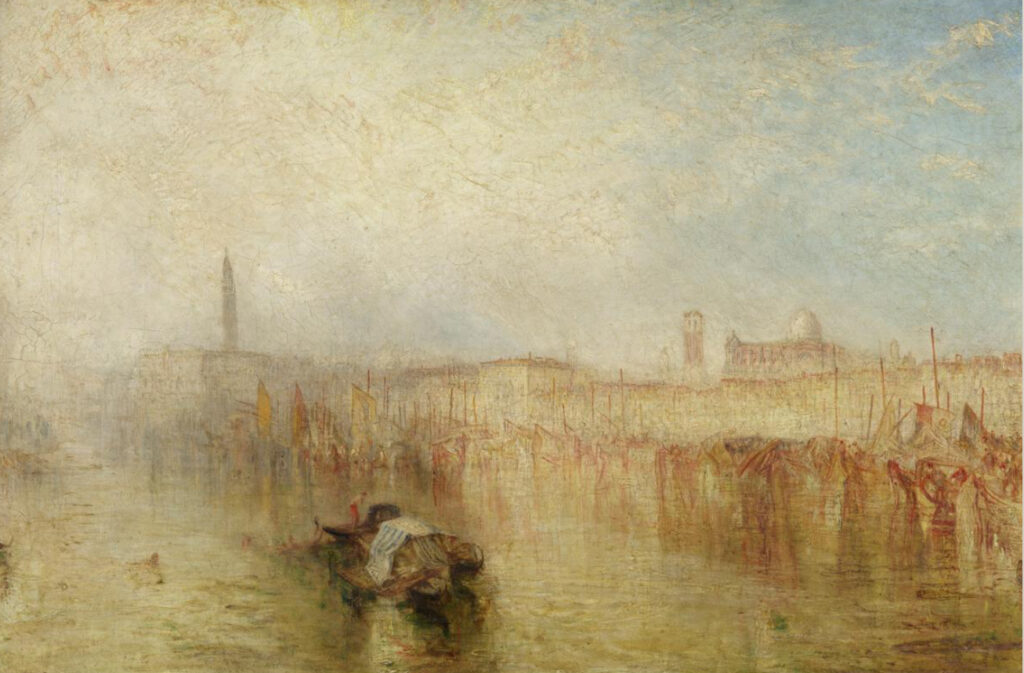
ChatGPT: The pairing of Offenbach’s Barcarolle with Turner’s painting “Venice Quay, the Riva degli Schiavoni” (1844) creates a multisensory experience that significantly enhances emotional and aesthetic appreciation—and neuroscience can explain why.
🧠 How the Brain Reacts to Art and Music Together
1.
Multisensory Integration – The Brain as a Synthesizer
- The superior temporal sulcus and posterior parietal cortex are responsible for combining different sensory modalities (vision + sound).
- When you look at Turner’s hazy, light-filled Venice while listening to the swaying rhythm of Barcarolle, your brain fuses the two into a single, enhanced emotional impression.
- This binding process deepens memory, mood, and meaning.
Result: You don’t just see the painting—you feel it move and breathe.
2.
Mirror Neurons and Emotional Resonance
- Music like Barcarolle activates mirror neuron systems, allowing the listener to empathize with the emotional tone of the song.
- The gentle duet creates a sense of intimacy and stillness, matching the soft dissolving forms in Turner’s painting.
- This alignment evokes a feeling of romantic reverie—as if one is drifting, both literally (on a gondola) and metaphorically (through time and memory).
The viewer’s brain mirrors the serenity and longing both in sound and image.
3.
Dopaminergic Reward Pathways – Pleasure in Harmony
- The mesolimbic system, especially the nucleus accumbens, releases dopamine in response to musical and visual beauty—especially when the two align in tone.
- Turner’s golden light, soft focus, and dreamy water reflections act like visual harmony.
- Barcarolle’s swaying rhythm and melodic consonance create auditory harmony.
When these harmonies match emotionally, your brain’s reward system lights up more intensely than for either one alone.
4.
The Default Mode Network (DMN) – Imagination and Memory
- Both Turner’s painting and Offenbach’s music invite internal wandering: romantic memory, daydreaming, fantasy.
- The DMN becomes active, linking the viewer’s personal memories of water, light, love—or imagined ones.
This mental drift amplifies the painting’s emotional pull beyond the visual.
5.
Temporal Entrainment – Barcarolle and the Gaze
- The 6/8 rhythm of the music subtly entrains the viewer’s attention: the eyes move more slowly, gently, in sync with the sway of the music.
- This slows perception, allowing the viewer to absorb Turner’s soft transitions and atmospheric dissolves more deeply.
The music paces the gaze, making the painting feel alive and cinematic.
🎨🎶 Conclusion:
Pairing Barcarolle with Turner’s Venetian mist and glimmer isn’t just poetic—it’s neuroaesthetic.
It works because:
- Both trigger parallel emotional circuits
- They entrain attention in a fluid, dreamlike rhythm
- The brain binds them into a single, emotionally heightened memory
You don’t just see Turner’s Venice—you float through it.
From the perspective of anthropology, how do people react without the pre-knowledge of Venice or the interpretation of song? Could they still feel the romantic connection? Or the reaction is pre determined by culture?
ChatGPT :
This is a profound and nuanced question. From the anthropological perspective, the answer lies at the intersection of universal human capacities and cultural conditioning.
🌍 Can people without pre-knowledge of Venice or the song still feel the romance?
Yes — to a degree.
But how they feel, interpret, or assign meaning to the feeling often depends on their cultural framework.
🧬 1.
Universals in Human Perception (Cross-Cultural Tendencies)
Anthropologists like Alan Lomax and ethnomusicologists like John Blacking showed that:
- Certain musical features (slow tempo, soft dynamics, harmonious intervals) are universally associated with calm, intimacy, and emotional depth.
- The lilting 6/8 rhythm of the Barcarolle mimics human movement—rocking a baby, swaying during courtship—which creates a somatic (bodily) sense of safety or tenderness.
- Vocal harmonization, especially female duets in thirds and sixths, can sound soothing or intimate across cultures—even when the language is unknown.
So yes, even without Venice or a translation, many listeners could feel that the song is “about love” or “about something beautiful and intimate.”
🌐 2.
But Meaning Is Filtered Through Culture
- In cultures that do not use Western tonality, the harmonic and melodic structure may not immediately signal “romance”—it might sound “foreign,” ceremonial, or neutral.
- Venetian gondolas, moonlit canals, European femininity are all Western cultural icons. Without those associations, the listener doesn’t imagine Venice—they imagine something else, or nothing at all.
- In some societies, romance is not publicly sung about; emotional restraint is more valued than expression. So the reaction may be aesthetic, but not personally romantic.
The emotion might be felt—but its interpretation depends on the cultural “lens.”
📖 3.
Cultural Scripts and Musical Semiotics
Anthropologist Clifford Geertz wrote about how culture is a “web of meaning”. In music:
- We “read” songs through semiotic scripts (signs and meanings we’ve learned).
- The Barcarolle’s meaning in the West = “Venice + Night + Love”
But in another culture, the same sonority might signify ritual purity, mourning, or pastoral nostalgia.
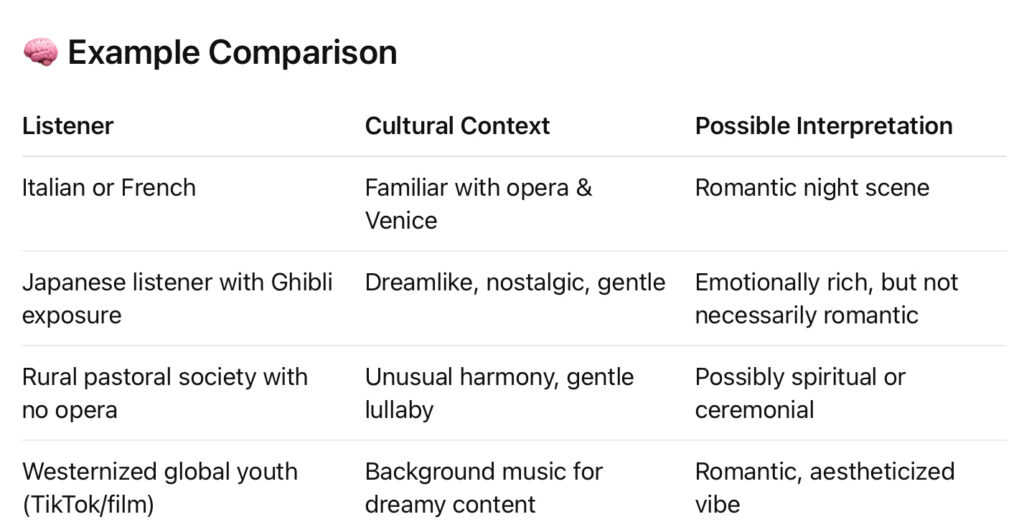
🎵 Conclusion:
- Romantic response to the Barcarolle is partly universal (sound as feeling)
- But its meaning—Venice, love, night—is culturally coded
So people without pre-knowledge can feel, but what they think they’re feeling (and why) is largely a cultural construct.
Let’s explore a non-Western musical piece that evokes similar dreamy or romantic emotions to Offenbach’s Barcarolle—but through entirely different musical structures and cultural meanings.
🎵 Example:
“Yumeji’s Theme”
from
In the Mood for Love
(2000)
Context: Accompanies scenes of unspoken love and emotional tension in Wong Kar-wai’s film
Composer: Shigeru Umebayashi
Origin: Japan/Hong Kong
Style: Slow, minor-key waltz with bowed strings and restrained phrasing
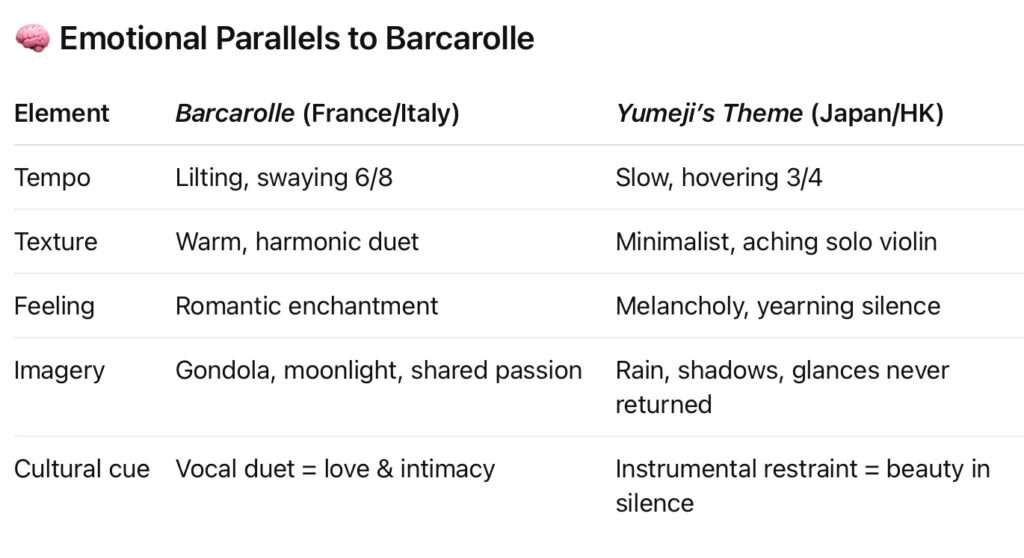
🔍 Anthropological Insight:
- In Barcarolle, love is sung, externalized, and illuminated by moonlight.
- In Yumeji’s Theme, love is withheld, internalized, and shaped by social norms of restraint—especially in traditional East Asian cultures where emotion is often expressed through subtle gestures rather than overt confession.
Yet both pieces stir the limbic system, and both evoke longing—but one expresses it as shared rapture, the other as quiet ache.
🎼 Other Non-Western Parallels
1.
North Indian Raga – Raga Yaman
- Played at twilight, often associated with love and yearning.
- Uses microtonal bends, drone accompaniment, and melodic improvisation to create a meditative emotional state.
- No harmony or fixed rhythm like Barcarolle, yet listeners often report feeling a sense of floating tenderness.
2.
Persian Classical Music – Dastgah Mahur
- Considered bright and lyrical—often performed on instruments like kamancheh or setar.
- The melodic lines unfold slowly, evoking subtle emotional colors without overt “romantic” cues.
- A poetic listener might still associate it with love or beauty, even if those aren’t culturally explicit.
🪞 Final Thought:
Across cultures, music can access shared human emotions, but each culture builds its own emotional language from those feelings.
- Barcarolle speaks in lyric beauty and shared love.
- Yumeji’s Theme whispers in silence and shadow.
- A raga or Persian melody blooms slowly, leaving room for inward meditation.
Romance, then, is a song the heart knows—but the world teaches us how to sing it.

Wired for Joy: The Future of Growing Older

ChatGPT:
Enhancing Joyspan through Digital Technologies: The Future of Aging Well
The aspiration for a long life has guided humanity for centuries, but modern discussions increasingly emphasize not merely extending lifespan or healthspan, but enriching the “joyspan,” a concept introduced by Kerry Burnight, a gerontologist who asserts that a meaningful life requires sustained joy and emotional fulfillment. Simultaneously, advancements in digital technologies provide unprecedented opportunities to foster happiness, leisure, social connection, and adaptability among aging populations. Merging the ideas from the “Joyspan” article and research from MDPI on digital enhancement reveals a comprehensive strategy for aging well in our rapidly digitalizing world.
Understanding Joyspan: The Art of Thriving
Burnight’s “Joyspan” philosophy pivots around four essential, nonnegotiable actions: Grow, Adapt, Give, and Connect. Each emphasizes active participation, emotional resilience, and positive engagement, promoting happiness irrespective of age or physical constraints.
Grow underscores continuous learning and curiosity, vital for cognitive health and emotional well-being. Examples from Burnight’s research highlight older adults undertaking new ventures, such as becoming substitute teachers post-retirement. This ongoing intellectual curiosity supports neural plasticity and provides purposeful enjoyment in later life.
Adapt highlights the critical skill of adjusting positively to inevitable life changes. Individuals who gracefully transition their activities—such as swapping in-person shopping for digital grocery services when physical mobility declines—demonstrate improved mental health and sustained happiness.
Give emphasizes that meaningful generosity, whether through teaching skills, volunteering, or simple kindness, deeply enriches emotional life and fosters a sense of purpose and community belonging.
Connect captures the essential nature of social bonds and relationships, underscoring the critical role of companionship, conversation, and communal activities in promoting mental health and overall happiness.
Burnight’s framework is validated extensively by gerontological research highlighting cognitive stimulation, adaptability, social engagement, and altruism as central to emotional well-being among seniors.
Digital Technologies: Enhancing Elderly Well-being
Complementing Burnight’s Joyspan, recent MDPI research examines how leisure and happiness correlate significantly among older adults, pinpointing key predictors of well-being, including leisure satisfaction, social companionship, and accessible community resources. Digital technologies increasingly play a critical role in enhancing these happiness factors, addressing barriers traditionally associated with aging.
Digital Access to Leisure and Satisfaction
Digital technologies provide elderly individuals with enriched leisure experiences, significantly boosting leisure satisfaction. Virtual reality (VR) technologies, online educational platforms, and interactive hobby-oriented communities can significantly enhance seniors’ quality of life. For instance, seniors participating in online courses or virtual travel experiences report elevated levels of curiosity and joy, directly aligning with Burnight’s growth principle. Platforms offering remote engagement, such as virtual museum tours or online hobby groups, effectively circumvent physical limitations while fostering continuous cognitive and emotional stimulation.
Adaptability through Digital Solutions
The capability to adapt gracefully to life changes is crucial to maintaining happiness as individuals age. Digital innovations offer seniors adaptable alternatives to traditional activities, ensuring continuous participation despite physical or cognitive decline. Seniors who struggle with mobility issues can transition smoothly from physically demanding hobbies, such as hiking or running, to digitally facilitated alternatives, including exergaming or fitness tracking apps tailored specifically to their needs. Similarly, the shift from traditional book reading to audiobooks or digital reading platforms effectively addresses declining eyesight without compromising the joy of engaging with literature.
Generosity and Digital Giving
Digital technologies also enhance opportunities for seniors to give meaningfully. Online platforms such as AARP’s Create the Good program match senior volunteers with suitable opportunities, increasing their ability to contribute positively to their communities from home. Digital volunteering, mentorship programs, or community forums enable older adults to share their wisdom, experiences, and skills effortlessly and conveniently. These digital opportunities amplify the potential for older adults to achieve emotional fulfillment through meaningful generosity and communal contributions.
Strengthening Social Connections Digitally
The MDPI research emphasizes the substantial correlation between social connectivity and elderly happiness. Digital technology bridges gaps caused by geographical distance, mobility issues, or isolation. Platforms enabling easy video conferencing, virtual game nights, or shared multimedia experiences have become indispensable in maintaining and expanding social bonds. Burnight notes the significance of maintaining relationships actively, and digital platforms substantially simplify initiating and maintaining these connections. Seniors who regularly interact digitally with friends, family, or social groups report lower feelings of isolation and enhanced emotional resilience.
Digital Inclusion and Bridging the Technological Gap
To effectively harness digital technology’s full potential in promoting Joyspan, addressing digital exclusion becomes paramount. Barriers including digital illiteracy, lack of accessibility, and inadequate infrastructure disproportionately affect older adults, limiting their ability to benefit fully from technological advancements. Addressing this through senior-friendly designs, intuitive interfaces, assisted technology training programs, and supportive public policies can dramatically expand digital inclusion, ensuring equitable happiness benefits across socio-economic and geographical boundaries.
Augmented Reality (AR)-enabled tutorials and simplified mobile platforms have been successful in improving older adults’ technological comfort, empowering them to integrate digital solutions effectively into their daily lives. Communities and policymakers must prioritize programs addressing digital gaps, facilitating broader access to these critical happiness-enhancing tools.
Ethical Considerations and Privacy
Integrating digital solutions in elder care also necessitates careful consideration of ethical implications, particularly data privacy and consent. Ensuring transparent, user-controlled data management systems strengthens trust among older adults, alleviating concerns that might otherwise discourage technological adoption. Digital ethics frameworks focusing specifically on elder care settings could guide responsible technology integration, addressing concerns proactively and enhancing seniors’ confidence in using digital platforms extensively.
Emerging Frontiers: IoT, AI, and Digital Twins
The future promises even more sophisticated digital innovations with significant potential for elder well-being. Internet of Things (IoT)-enabled home environments enhance independent living by providing seniors with real-time safety and health monitoring, enabling safe leisure participation without constant supervision. Digital twins—virtual models that replicate seniors’ environments to optimize their living conditions—are emerging as powerful tools for personalized, adaptive living support, integrating seamlessly with seniors’ daily routines and enhancing their overall well-being and happiness.
Artificial intelligence (AI)-driven personalized assistance platforms further complement Joyspan principles, offering tailored leisure and learning experiences, personalized health advice, and predictive tools to enhance adaptability and resilience proactively.
Implementing an Integrated Approach
A combined strategy integrating Burnight’s Joyspan model with digitally-enhanced leisure and social frameworks offers a holistic approach to aging happily and meaningfully. Practical applications include:
- Community digital hubs offering accessible training and support.
- Virtual leisure networks encouraging lifelong learning and cognitive engagement.
- Adaptive digital leisure solutions tailored to individual physical and cognitive capabilities.
- Digital platforms promoting intergenerational exchanges, mentorship, and meaningful volunteering.
- Policy initiatives supporting equitable digital infrastructure, targeted specifically towards aging populations.
Conclusion: Digital Joyspan as a Pathway Forward
The synergistic potential of Joyspan and digital technologies signals a promising evolution in aging experiences. By proactively leveraging technology to facilitate learning, adaptability, generosity, and social connection, societies can profoundly enhance older adults’ emotional and psychological well-being. As we continue to embrace technological advancements, the essential goal remains clear: to ensure that longevity is not just about adding years to life, but genuinely adding joyful, meaningful life to those years.
Canal-gebra: Solving for Chaos
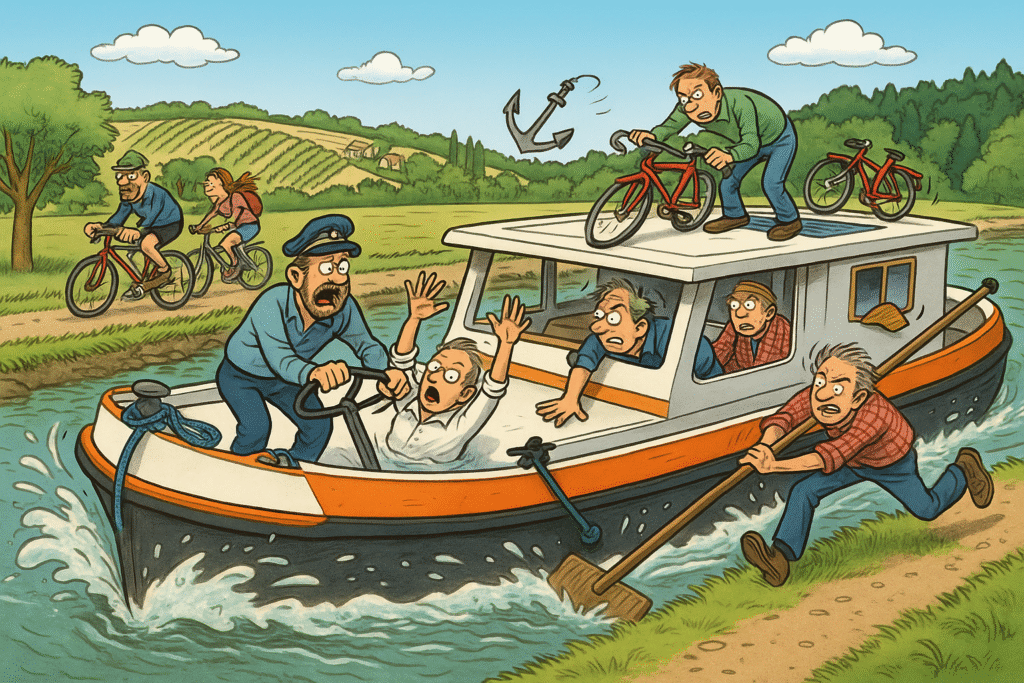
ChatGPT:
Title:
“From Steering Wheel to Tillering Fiasco: A Guide to the Glorious Misery of Driving a Barge in France”
Or: How to Go from Linear Logic to Nonlinear Regret in 68 Locks or Less
INTRODUCTION: LINEAR EXPECTATIONS, NONLINEAR HUMILIATION
Let’s start where your journey began—in a car. A beautiful, obedient machine that does exactly what you ask of it (except parallel parking). You turn the wheel a little, the car turns a little. You turn it more, the car turns more. That’s a linear system—predictable, friendly, basically the golden retriever of physics.
And then one day you think, “What if I drove a barge in France?”
This is where the wheels fall off—metaphorically, of course, since barges don’t have wheels, just your shattered expectations drifting downstream.
Driving a barge is not like driving a car. It’s not like driving anything. It’s like writing a strongly worded letter to the water and hoping it eventually obeys. This, dear reader, is your introduction to nonlinear systems, canal-based suffering, and the extremely avoidable chaos of self-driving holidays in French inland waterways.
CARS: SIMPLE MACHINES FOR SIMPLE JOYS
Before we throw you in the canal of consequences, let’s appreciate the simplicity of your car:
- You steer left → it goes left.
- You stop accelerating → it slows down.
- You hit the brakes → it stops (shockingly useful).
- You arrive on time, in control, with dry shoes.
All this is possible because the mechanics of driving a car are linear:
- Inputs and outputs scale predictably.
- You control the direction directly.
- There’s friction with the road.
- Newton’s laws behave themselves.
Driving a car makes you feel competent.
Driving a barge makes you question your life choices.
BARGES: GIANT, FLOATING MATH JOKES
Now enter the barge—a vehicle that does not obey logic, gravity, or your shouted instructions.
Let’s clarify something: you don’t “drive” a barge. You negotiate with it. Slowly. Desperately.
Here’s why barges are textbook nonlinear systems:
1.
Delayed Response
You steer—and nothing happens. Then, after a suspenseful pause, it turns way too much. Then you overcorrect. Then that overcorrects. You’re now spinning. Congratulations: your barge is doing interpretive dance.
2.
Momentum from Hell
Your barge is 50 feet long, made of steel, and weighs more than your self-esteem. Once it’s moving, it does not want to stop. No brakes. You slow down with reverse thrust and prayers.
3.
Wind is Your Enemy
A mild breeze will push your barge diagonally into the bank like a bored toddler swatting a toy. Any side wind turns your entire vessel into a sluggish kite.
4.
Rudder-based steering
You don’t steer the barge itself. You redirect water, and the water slowly nudges the stern, which slowly swings the front, which slowly turns the barge. All of this happens just slowly enough for you to think nothing’s happening—until it’s too late.
THE UNFORESEEN HAZARDS OF THE FRENCH CANAL SYSTEM
You thought, “Ah, France. Wine. Cheese. Floating gently past castles.”
And you were wrong.
⚠️
Locks. So Many Locks.
Some canals—like the infamous Canal de Bourgogne—have 60+ locks per week. Each one is a hydraulic mood swing that requires:
- Tying ropes in a panic
- Shoving the barge off walls with a boat hook
- Screaming “IS IT OPEN YET?”
- Possibly launching a crew member into the water (accidentally)
⚠️
Wind from the Mediterranean
On canals like the Rhône à Sète, sea winds slam into your barge like an air-powered slapstick routine. You’ll try to steer forward and end up on the wrong bank, angled like you’re ashamed of your own trajectory.
⚠️
Overconfident Crew
There’s always a retired navy captain who says, “We can go faster.”
There’s always someone who thinks “mooring next to a lock during lunch” is safe.
There’s always a tech guy who can code in 14 languages but uses a mooring pole like a catapult.
HOW TO ACTUALLY STEER A BARGE (WITHOUT BECOMING A TRAGIC MEME)
📍 Before You Start:
- Assign roles. Someone steers. Someone mans the ropes. Someone points at ducks.
- Check wind conditions. If trees are moving, your barge will too.
- Test your tiller. Left is right. Right is left. This is not a metaphor.
📘 THE BARGE STEERING MANUAL (with Sarcasm-Free Translation)
STEP 1:
Throttle is your lifeline
- Always steer with some forward momentum. No speed = no rudder control.
- Reverse = your brake. Use it early and gently.
STEP 2:
To turn left, push the tiller right
- This moves the back of the barge right, swinging the front left.
- WAIT. Let the barge respond. Do not wiggle it like a Wii controller.
STEP 3:
Wind management
- Point the bow slightly into the wind to counter sideways drift.
- If you drift too much, stop everything. Reposition slowly.
- Side wind? Expect to hit the bank at least once. Just pretend it was on purpose.
STEP 4:
Approaching a lock
- Slow down way earlier than feels necessary.
- Come in at an angle—line up as you enter.
- Throw mooring lines to your rope guy (hopefully not the one who fell in last time).
- Reverse gently to halt inside the lock.
STEP 5:
Mooring like a civilized person
- Use two mooring lines minimum.
- Hammer poles fully into the bank (not just half-hearted taps).
- Never moor next to an active lock. Just don’t. Trust us.
STEP 6:
Turning Around (God Help You)
- Use reverse and full rudder in open canal sections only.
- Accept that it will take three tries and half your pride.
PRO TIPS (FROM PEOPLE WHO SURVIVED)
- Bring gloves. Rope burn is not romantic.
- Assign designated sober crew during lunch stops.
- Carry a boat hook—for pushing off the bank and fishing out crew members who “slipped.”
- Respect the 8 km/h limit. It’s not a suggestion. It’s a physical law of barge equilibrium.
- Don’t fight the barge. Think like a barge. Slow. Heavy. Majestic. Confused.
FINAL THOUGHTS: YOU’LL SURVIVE (PROBABLY)
You’re not just on vacation. You’re taking part in a centuries-old dance of water, physics, and human misjudgment.
Will you drift?
Yes.
Will you spin?
Almost definitely.
Will you moor perfectly?
No, but you’ll lie about it later.
And one day, after the blisters have faded and the wine has worn off, you’ll find yourself at a dinner party, swirling your glass, and someone will say,
“Didn’t you do a barge trip in France?”
And you’ll smile and reply:
“Ah yes. We lost an anchor. Nearly overtook a nun’s barge. Pushed a CEO into the canal. It was wonderful.”
And that, my friend, is barge life.
Suggested reading:
- “Zen and the Art of Not Overcorrecting”
- “Advanced Rope Tossing for Business Executives”
- “How Not to Blame the Wind (Even Though It Was Definitely the Wind)”
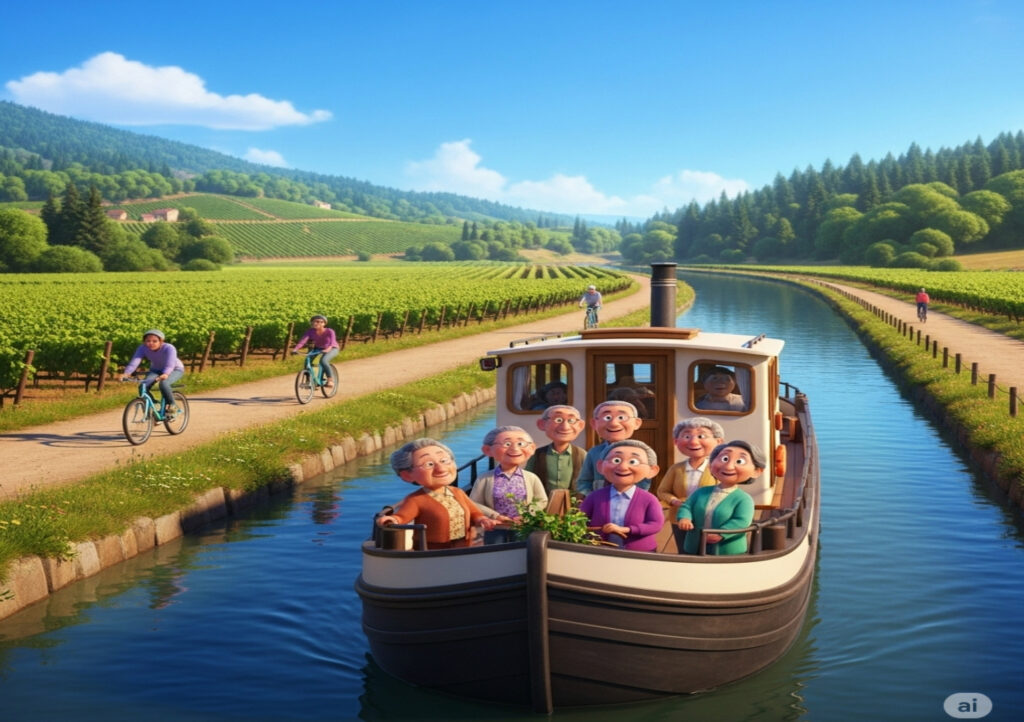
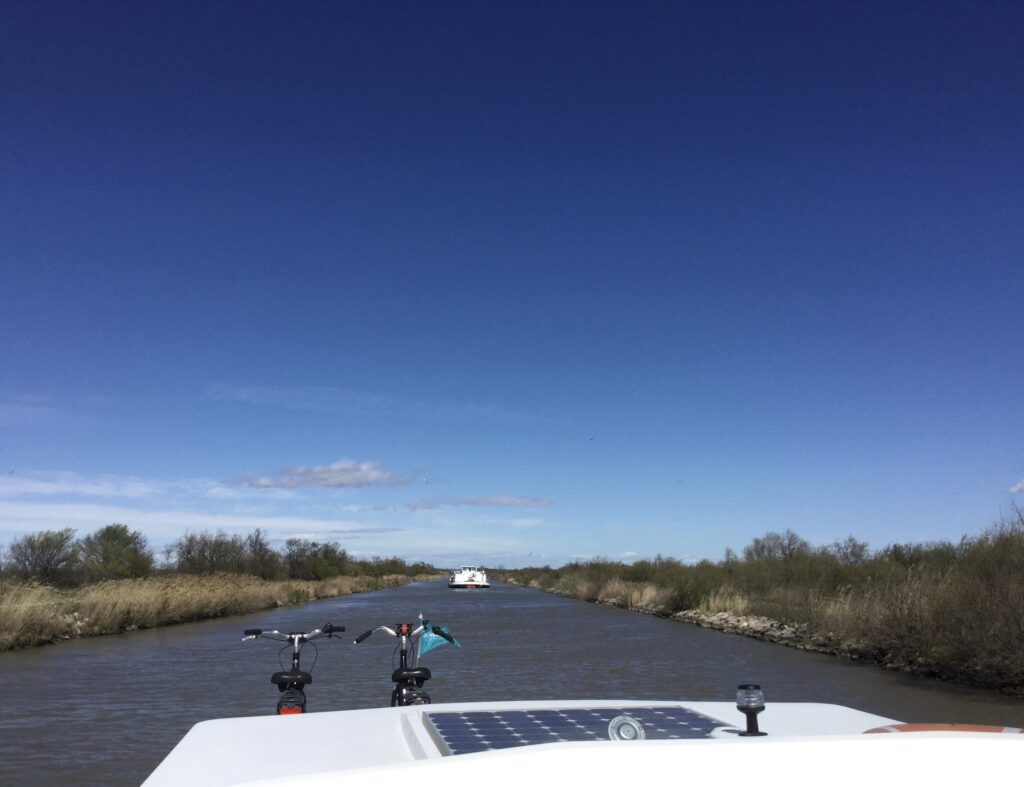
Decode Your Decisions

ChatGPT:
Thinking, Fast and Slow
by Daniel Kahneman
Daniel Kahneman’s Thinking, Fast and Slow is a groundbreaking exploration of how the human mind works, focusing on the dual systems of thinking that drive our decisions. It combines decades of research in psychology and behavioral economics to reveal the cognitive biases and heuristics that affect our judgment.
🎯 Conclusion
In Thinking, Fast and Slow, Kahneman explains that our minds operate through two systems: System 1, which is fast, intuitive, and emotional, and System 2, which is slower, deliberate, and logical. Most of our daily decisions rely on System 1, making us vulnerable to errors in judgment. Kahneman presents compelling experiments and studies showing how this reliance leads to biases like loss aversion, framing effects, and overconfidence. He challenges the assumption of human rationality in economics, showing that we often act against our best interests due to flawed thinking patterns. The book closes with reflections on how to guard against these biases, even though eliminating them completely is impossible. Overall, it’s a powerful call for self-awareness and better decision-making through understanding our mental shortcuts.
🧠 Key points principales
🧩 System 1 and System 2: Our brain runs on two modes—fast, automatic thinking and slow, effortful reasoning.
💡 Cognitive biases: We’re prone to systematic errors, like anchoring, availability heuristics, and the halo effect.
📉 Loss aversion: Losses feel twice as painful as gains feel good, skewing risk assessment.
📊 Framing effects: The way a choice is presented dramatically changes how we perceive it.
👁️ WYSIATI (What You See Is All There Is): We make decisions based only on the information immediately available, ignoring what’s missing.
🧠 Substitution: When faced with a hard question, we often answer an easier one without realizing it.
🔢 Base rate neglect: We ignore statistical realities in favor of vivid personal anecdotes or stereotypes.
🗣️ Overconfidence bias: People consistently overestimate their knowledge and predictions.
📉 Regression to the mean: Extreme outcomes tend to be followed by more average ones, yet we often misattribute the change.
🧪 Prospect Theory: A cornerstone of behavioral economics explaining how people evaluate potential losses and gains asymmetrically.
📚 Summary resumido
- Two Systems of Thinking: Kahneman describes System 1 as fast, automatic, and emotional, while System 2 is slow, analytical, and effortful. Most decisions are unconsciously made by System 1, with System 2 intervening only when necessary.
- Heuristics and Biases: We rely on mental shortcuts to make decisions quickly, but these often lead to predictable biases such as the anchoring effect and availability heuristic.
- Overconfidence and Intuition: People often trust their gut feelings even when these are based on flawed reasoning. Kahneman shows how confidence is a poor indicator of accuracy.
- Loss Aversion: People react more strongly to losses than to equivalent gains. This bias heavily influences financial and personal decisions.
- Framing Effects: The way information is presented can influence decisions more than the content itself—for example, “90% survival rate” sounds better than “10% mortality rate.”
- The Illusion of Understanding: We construct coherent narratives around past events, giving us false confidence in our knowledge and predictions.
- Intuition vs. Expertise: Genuine expertise requires an environment with regular patterns and feedback. In many areas, intuition is no better than chance.
- Prospect Theory: Co-developed by Kahneman, it refutes classical economic models by showing that people value gains and losses differently, leading to irrational choices.
- The Planning Fallacy: People systematically underestimate the time, costs, and risks of future actions and overestimate the benefits, leading to overly optimistic plans.
- Experiencing Self vs. Remembering Self: Kahneman distinguishes between the part of us that experiences life moment by moment and the one that remembers and judges it, which often misrepresents reality.
📌 Quotes from
Thinking, Fast and Slow
by Daniel Kahneman
Here are some of the most powerful and insightful quotes from the book, capturing its key ideas and wisdom for life and decision-making:
- “Nothing in life is as important as you think it is, while you are thinking about it.”
– A reminder of how our attention skews our perception of importance. - “We are prone to overestimate how much we understand about the world and to underestimate the role of chance.”
– On the illusion of understanding and randomness. - “The confidence people have in their beliefs is not a measure of the quality of evidence but of the coherence of the story the mind has managed to construct.”
– Confidence is often misleading. - “What you see is all there is.”
– The WYSIATI principle: We base decisions on available information, ignoring what we don’t see. - “The idea that the future is unpredictable is undermined every day by the ease with which the past is explained.”
– On hindsight bias and narrative fallacy. - “Losses loom larger than gains.”
– The core idea of loss aversion in Prospect Theory. - “A reliable way to make people believe in falsehoods is frequent repetition, because familiarity is not easily distinguished from truth.”
– The danger of repeated misinformation. - “We can be blind to the obvious, and we are also blind to our blindness.”
– The limits of self-awareness. - “Intuitive errors are not restricted to the intellectually limited. They are not a feature of irrationality, but of the workings of normal cognition.”
– Everyone is susceptible to biases, regardless of intelligence. - “Expert intuition strikes us as magical, but it is not. It is recognition.”
– The truth behind intuition: pattern recognition in consistent environments. - “The experiencing self does not have a voice. The remembering self is sometimes wrong, but it is the one that keeps score and makes the decisions.”
– On how memory shapes our life choices. - “You are more likely to learn something by finding surprises in your own behavior than by hearing surprising facts about people in general.”
– Self-awareness as a learning tool. - “Optimistic bias may well be the most significant of the cognitive biases.”
– On why we often misjudge risk and overestimate success. - “People tend to assess the relative importance of issues by the ease with which they are retrieved from memory—and that is largely determined by the extent of coverage in the media.”
– Media’s role in shaping perception. - “An individual who expresses high confidence probably has a good story, not necessarily a good understanding.”
– Confidence ≠ competence.
❓Frequently Asked Questions about
Thinking, Fast and Slow
What is the central idea of
Thinking, Fast and Slow
?
The book explores how the human brain uses two systems of thinking: System 1 (fast, intuitive) and System 2 (slow, deliberate). Kahneman shows how most decisions are made by System 1, leading to predictable cognitive biases.
Who is Daniel Kahneman?
Daniel Kahneman is a Nobel Prize-winning psychologist known for his work in behavioral economics, especially on judgment, decision-making, and cognitive biases. He co-developed Prospect Theory with Amos Tversky.
What is System 1 thinking?
System 1 is fast, automatic, emotional, and subconscious. It helps us handle everyday tasks efficiently but is prone to errors and biases due to its reliance on intuition and shortcuts.
What is System 2 thinking?
System 2 is slow, effortful, logical, and conscious. It’s responsible for deep thinking, analysis, and complex decisions—but it’s lazy and often lets System 1 take over.
What is the Prospect Theory?
Prospect Theory explains how people evaluate risk and reward. Unlike classical economics, it shows that losses feel worse than equivalent gains, leading people to make irrational decisions under uncertainty.
What is “loss aversion”?
Loss aversion refers to the idea that people feel the pain of losses about twice as strongly as the pleasure of gains. This bias explains why we often avoid risk, even when the potential benefits outweigh the costs.
What does “What You See Is All There Is (WYSIATI)” mean?
WYSIATI is the principle that people make judgments based on the information available to them, ignoring missing or unknown data. It leads to overconfidence and flawed reasoning.
Why is intuition often unreliable?
Intuition relies on pattern recognition and works well in stable environments with frequent feedback. In unpredictable domains (like investing or hiring), intuition often fails due to bias and noise.
How does the book explain overconfidence?
Kahneman shows that confidence does not correlate with accuracy. People often overestimate their knowledge, skills, and predictions, leading to bad decisions—especially in complex or uncertain environments.
How can I apply this book in real life?
Use System 2 thinking for important decisions, be aware of cognitive biases, seek diverse perspectives, and use data-driven approaches like reference class forecasting. Awareness of these tendencies can help reduce error and improve judgment.
Trust, Tricks & Transactions

ChatGPT:
Hidden Conflicts in Finance
This lecture by Professor Raghavendra Rau (Cambridge University) inaugurates a series exploring the human side of finance. It delves into how promises—central to financial contracts—are valued, and the often-hidden conflicts embedded in financial systems, especially those arising from principal-agent dynamics, intermediaries, and the emergence of private money like stablecoins.
🎯 Conclusion
Finance, at its core, revolves around valuing promises—whether from companies, governments, or individuals—and managing the conflicts that arise from these promises. While classical finance assumes rational markets, the human side introduces behavioral and structural problems, most notably principal-agent conflicts. These conflicts arise when those entrusted to act on behalf of others (agents) may have diverging incentives from the principals they serve. Financial intermediaries, such as banks and mutual funds, play crucial roles but can also harbor hidden risks. The rise of stablecoins mirrors historical patterns in private money but raises new regulatory concerns. Ultimately, although financial systems have evolved with more formal contracts and regulations, they remain susceptible to asymmetry, behavioral biases, and complexity-driven conflicts.
🔑 Key points
📜 Finance = Promises: Financial instruments are built on promises to pay or deliver future value in exchange for money today.
⚖️ Two valuation lenses: Classical finance values using data and models; behavioral finance considers human biases and trust.
🧑💼 Principal-agent problem: When agents (executives, fund managers, etc.) act on behalf of principals (investors) but have conflicting interests.
🏦 Banks’ core roles: Banks act as matchmakers, risk managers, liquidity providers, and information processors in the economy.
📉 Bank runs: Triggered by fear, bank runs reveal vulnerabilities in the mismatch between short-term liabilities and long-term assets.
🔐 Implicit contracts: Trust-based unwritten agreements—common in long-term or high-trust relationships—can substitute for rigid contracts.
💵 Stablecoins: Cryptocurrencies pegged to fiat currencies function like banks but with looser regulation and greater run risk.
🌐 Eurodollar market: A massive, loosely regulated offshore dollar system (~$12.8 trillion) that complicates monetary control.
📊 Regulatory gaps: Financial innovations often outpace oversight, as seen with crypto and DeFi, creating new risks.
🧠 Behavioral economics: Even rational-looking systems are shaped by psychology, herd behavior, and information asymmetry.
🧠 Summary
- Finance as promises: Finance is based on exchanging money now for future commitments (stocks, bonds, insurance). Two major perspectives assess these promises: rational valuation and human behavior.
- Human side of finance: Market behavior is affected by trust, incomplete contracts, and the potential for fraud, complicating valuation and decision-making.
- Role of financial intermediaries: Banks and funds reduce transaction costs, offer liquidity, transform maturity, and assess risk on behalf of individuals and businesses.
- Principal-agent problem: Occurs when those making decisions (agents) have incentives that diverge from those providing the capital (principals), evident across finance, real estate, and politics.
- Mechanisms to control agents: Contracts, legal regulations, and reputational dynamics are used to align interests, though none are foolproof.
- Value of implicit contracts: In trust-based or flexible settings, unwritten rules (e.g., job security or customer loyalty) can be more effective than formal agreements.
- Bank functions and profits: Banks profit from interest spreads, maturity transformation, and payment facilitation. Their lending increases money supply.
- Preventing bank runs: Tools include deposit insurance, capital and liquidity requirements, and central bank backstops. Yet digital finance introduces new risks.
- Rise of stablecoins: Digital fiat-pegged currencies like USDC and USDT operate like banks but lack full regulation, risking modern “crypto runs.”
- Global money creation: Commercial banks—not central banks—create most money through lending. The Eurodollar market further complicates global financial control.
*********
What is the principal-agent problem in finance?
The principal-agent problem arises when one party (the principal) hires another (the agent) to act on their behalf, but the agent’s interests may not align with the principal’s. For example, shareholders expect CEOs to maximize shareholder value, but CEOs might prioritize personal benefits instead.
How do financial intermediaries like banks add value to the economy?
Banks match savers with borrowers, transform short-term deposits into long-term loans, manage and spread risk, produce financial information, and provide liquidity. These functions enable efficient capital allocation and smoother economic activity.
What mechanisms exist to control agents in financial relationships?
Controls include explicit contracts (e.g., performance-linked pay), legal regulations (e.g., fiduciary duties, financial disclosure laws), and implicit contracts based on reputation and repeated interactions. A mix of these methods is often used.
Why are implicit contracts important in finance?
Implicit contracts are unwritten understandings based on trust, commonly found in long-term business relationships, mentorships, or professional services. They offer flexibility where formal contracts are too rigid or costly to enforce.
What causes bank runs, and how can they be prevented?
Bank runs occur when depositors withdraw funds en masse, fearing bank insolvency. Preventive measures include deposit insurance, capital and liquidity requirements, and central banks acting as lenders of last resort.
How do banks make money?
Banks earn through the interest rate spread—paying lower interest on deposits than they charge on loans. They also profit from fees, investment returns, and money creation via lending (the money multiplier effect).
What are stablecoins, and why are they significant?
Stablecoins are cryptocurrencies pegged to traditional currencies (like the US dollar) to maintain price stability. They facilitate fast digital transactions but carry risks due to lack of regulation and reserve transparency.
How does the Eurodollar market affect global finance?
The Eurodollar market involves U.S. dollars held in foreign banks, creating a parallel financial system. With an estimated size of $12.8 trillion, it influences global interest rates and undermines centralized monetary control.
Do central banks control the money supply?
Not entirely. Most money is created by commercial banks through lending. Central banks influence money supply indirectly through interest rates and reserve requirements but don’t directly control all money creation.
How has finance changed in the modern era?
Finance has shifted from trust-based local systems to global, regulated, and digitized networks. Despite formalization, new conflicts and asymmetries have emerged due to complexity, technology, and information gaps.
🎯 Key Takeaways (a.k.a. things you should know but probably won’t remember):
1.
Finance = Promises. Promises = Risk.
From stocks to insurance, everything is built on promises for future payouts. The real game is figuring out if the people making those promises are lying, stupid, or both.
2.
Classical vs. Human Finance:
- Classical finance is the MBA fan fiction version: efficient markets, DCF models, and spreadsheet-induced confidence.
- Human finance is actual reality: deception, incomplete contracts, asymmetric information, and the persistent hope that your fund manager isn’t just chasing his quarterly bonus.
3.
Principal-Agent Problem:
This is the academic way of saying: “People paid to act on your behalf often do what’s best for them instead.”
- CEOs redecorate their egos with shareholder money.
- Fund managers swing for the fences to earn bonuses.
- Politicians forget your name right after elections.
It’s like hiring a dog to guard your sandwich.
4.
Financial Intermediaries Are Supposed to Help…
…but they also create massive conflict potential. They:
- Match savers and borrowers (useful).
- Transform short-term deposits into long-term loans (risky).
- Manage risk via pooling (debatable).
- Pretend to be experts with your money (sometimes true).
- Add liquidity… until they don’t.
5.
Banks Are Giant Risk Factories:
They create money by lending more than they have. They profit from the interest rate spread, and when things go bad, they get government bailouts because… well, capitalism but make it inconsistent.
6.
Bank Runs: Still a Thing!
Northern Rock, Silicon Valley Bank, etc.—they prove we haven’t learned anything. Deposit insurance exists to calm the peasants, but moral hazard lives rent-free in boardrooms.
7.
Stablecoins: Crypto’s Weird Banking Cosplay
- Pretend money backed by maybe-money.
- Still prone to runs (TerraUSD says hi).
- Poorly regulated but highly influential.
- If they collapse, we all get to pretend we didn’t see it coming.
8.
The Money Supply Isn’t Really Controlled by the Central Bank:
Shocking, I know. Most money is created by commercial banks via lending. The Fed adjusts interest rates, but the Eurodollar market operates like a drunk cousin who can’t be grounded because he lives abroad.
🧠 Financial Advisor Commentary:
This lecture is an important reminder for investors, analysts, and regulation fetishists alike: finance is fundamentally human, and therefore fundamentally flawed.
The more layers you build to protect against risk—legal contracts, regulation, performance metrics—the more creative people get at exploiting loopholes. Even well-meaning systems eventually become bureaucratic mazes or tools of manipulation.
As a senior financial advisor, I’d say this lecture is a must-read for anyone who thinks compliance and modeling are enough. It reminds you to look behind the curtain, question the incentives, and not assume your fiduciary actually remembers what that word means.
🔚 Bottom Line:
You want safety? Buy Treasury bonds. You want real financial insight? Understand human behavior, not just spreadsheets. And maybe don’t trust a stablecoin named after a Roman god if you’re storing your retirement in it.
Now or Never: Time, Culture, and Control

ChatGPT:
We race through hours like coins tossed in a well,
Each task a bell that tolls for vacant gain.
Our calendars, like prisons, falsely tell
That movement soothes the soul or dulls the pain.
But speed is not a sign the heart is full,
Nor is the climb a proof the peak was meant.
The busiest hands may craft a life that’s dull,
The swiftest feet may pass what life once lent.
To chase is not to cherish—know the space
Where stillness holds more weight than frantic stride.
The root grows not in motion, but in place;
The truth is not in forward, but inside.
So pause—before you crown the clock as king,
And ask what meaning all this pace might bring.
**************
Title: “The Only Time I Have Is Now”: Sociological and Cultural Perspectives on Time
“I don’t know how many days, how many minutes or seconds left—the only time I have is now, this moment.”
This sentiment, seemingly personal and reflective, echoes a deeper philosophical and sociological truth: our understanding of time is not universal, fixed, or objective. Rather, time is a constructed experience—shaped by emotion, culture, power structures, and technology. It is one of the few constants in life that is experienced so inconsistently.
Sociologically, time is not merely a neutral backdrop for human action. Instead, it is a resource, a battleground, a form of control, and sometimes even a tool of oppression. In many Western societies, time is treated as a commodity to be spent, saved, or wasted. The minute hand doesn’t just move—it ticks with economic, social, and moral implications.
Time as a Social Construct
Sociologists have long argued that time is socially constructed—that is, its meaning and structure are shaped by human practices and cultural norms rather than any intrinsic property of the universe. E.P. Thompson, in his influential work Time, Work-Discipline, and Industrial Capitalism (1967), explored how the Industrial Revolution fundamentally altered people’s experience of time. Prior to industrialization, time was measured in tasks and natural cycles: you worked until the work was done, not until the bell rang. But with the rise of capitalism came the standardization of time, enforced by factory whistles and mechanical clocks.
This shift was not just technological—it was moral and ideological. Punctuality became a virtue, lateness a vice. Time was no longer a shared experience—it became a metric for productivity and a weapon of discipline. To be late was not just to miss an appointment; it was to violate a social code rooted in economic utility.
And we have inherited this moral economy of time. Contemporary life is full of language that reflects our relationship with time as a finite resource: we “spend” time, we “waste” it, we’re always “running out.” Yet ironically, in this supposed age of hyper-efficiency, we increasingly report feeling short on time. Sociologist Judy Wajcman calls this phenomenon “temporal dissonance”: the more we try to master time with digital calendars, productivity hacks, and 15-minute task lists, the more time seems to slip away from us.
Temporal Inequality
Another vital contribution of sociology is the recognition of temporal inequality. Not everyone has the same access to time. The rich can buy time—through housekeepers, nannies, drivers, and personal assistants. The poor often sell their time through wage labor, shift work, or gig economy tasks. Time, like money, is unevenly distributed.
This disparity also has a gendered dimension. Arlie Hochschild’s concept of the “second shift” reveals how women, even when employed full-time, often carry the burden of domestic labor after hours. So while a man may come home and enjoy “free time,” a woman may begin her unpaid second job as a caregiver, cleaner, and emotional manager. In this sense, time is not just measured in hours—it is measured in agency.
Acceleration and Modern Life
Sociologist Hartmut Rosa takes the critique of modern temporality a step further. In his theory of social acceleration, Rosa argues that technological, social, and economic systems are locked in a cycle of increasing speed. Faster communication, faster transport, faster lives. But paradoxically, this acceleration does not give us more time—it increases pressure, fragmentation, and the feeling that life is rushing past us.
Even leisure is infected by the tempo of acceleration. Vacations are planned with military precision, “self-care” is squeezed into 10-minute mindfulness apps, and sleep becomes a performance metric tracked by wearable devices. We have not escaped industrial time—we’ve digitized it and put it in our pockets.
Cross-Cultural Perspectives on Time
If sociology shows how time is constructed and stratified, cultural philosophy reveals how diverse those constructions can be. Different societies don’t just experience time differently—they conceptualize it in fundamentally contrasting ways.
Western Linear Time
Most Western cultures operate on a linear model of time: past, present, future. Influenced by Judeo-Christian theology, Enlightenment rationalism, and capitalist logic, this perspective views time as a progression. Life moves in a straight line—toward salvation, success, or retirement. This view favors planning, goals, and historical causality.
St. Augustine famously wrote about the puzzling nature of time in Confessions, noting that we remember the past, experience the present, and anticipate the future—but we do so all in the present. In a way, even the linear perspective admits that all time is, ultimately, now.
Indigenous and Cyclical Time
In many Indigenous cultures, time is not linear but cyclical or event-based. For example, in Australian Aboriginal traditions, the concept of Dreamtime transcends Western notions of chronology. It is not “long ago,” but a simultaneous, ever-present spiritual reality. In Native American and Andean worldviews, events are often understood in cycles tied to nature, ritual, and communal memory. Time here is relational and sacred, not something to be “used” but something to be lived within.
East Asian Temporal Philosophies
Daoism and Zen Buddhism also diverge from linear time. In Daoism, time is like water: flowing, unpredictable, and inherently meaningless unless aligned with the Dao, or the natural way. Rather than resist time, one should move with it. Zen Buddhism emphasizes mindfulness of the present moment, not because the future is irrelevant, but because attachment to past or future leads to suffering. Time is not the enemy—it is illusion, and enlightenment lies in transcending it.
African Event-Based Time
In many sub-Saharan African societies, time is understood through events and relationships rather than fixed schedules. Kenyan philosopher John Mbiti argued that time is “two-dimensional,” focused on the present and the past, with the future being vague and less emphasized. Events happen “when the people are ready,” not when the clock strikes. Here, time supports human needs, rather than demanding human efficiency.
The Moment We Have
So when someone says, “The only time I have is now,” they’re not just being poetic. They are, perhaps unknowingly, rejecting capitalist time, challenging linearity, and joining a chorus of traditions that prioritize presence over progress, being over doing.
From a sociological angle, this statement can be read as a rebellion against temporal discipline—a refusal to be commodified. From a cultural perspective, it is an affirmation of the lived, the sacred, the real.
The moment—this strange, elusive slice of being—is the one thing we all possess, even if just for a flicker. And yet, in chasing time, we often lose it. Philosophy and sociology together remind us that perhaps the most radical act in modern life is not to save time, but to experience it fully.
Because no one can say how many minutes or seconds are left. But the moment you’re in? That’s the one you own.
Your Golden Years Have Two Price Tags — Plan for Both

ChatGPT:
The Retirement Mirage: Why Your Financial Plan Needs Two Phases — And How to Prepare for Both
Most retirement planning conversations begin with hopeful visions of long-delayed vacations, days filled with hobbies, and more time with family. The spreadsheets are clean, the math looks solid, and your financial advisor may tell you something reassuring like: “Spending typically declines with age.” This is, in part, true.
But like most comforting generalizations, it hides a much messier reality. In fact, your retirement expenses are not a smooth downward slope. They’re more like a two-act play: Act One features fun and freedom, and Act Two, if you’re lucky enough to live long enough, brings a dramatic plot twist—one involving health issues, long-term care, and a rapidly shrinking nest egg.
To build a retirement strategy that actually holds up under pressure, you need to understand two contrasting trends:
- General retirement planners model a gradual decline in spending as you age.
- Long-term care planners model a sharp increase in costs late in life.
- Reality contains both.
In other words, your retirement plan needs to anticipate two financial phases:
- Phase One: Declining discretionary spending (fun stuff).
- Phase Two: Increasing non-discretionary care costs (necessary and often costly).
Let’s unpack this and see what you should be doing now to prepare.
Phase One: The “Go-Go” Years and the Myth of Declining Spending
Retirement planners often reference what’s affectionately known as the “go-go years” — typically the first decade or so after retirement. During this period, retirees tend to spend more freely on travel, dining, hobbies, grandchildren, and other forms of discretionary joy. This is when the “every day is Saturday” vibe is strongest.
After this initial burst of activity, spending tends to slow down naturally:
- People become less mobile.
- Big-ticket travel loses its appeal.
- Hobbies and events give way to quieter routines.
This trend is real and often supported by consumer data. Households led by someone aged 75 or older spend, on average, about 20% less than those in their mid-60s. For this reason, many advisors model retirement spending as gradually decreasing — a neat, downward-sloping line on your Excel chart.
But here’s the twist: that line doesn’t tell the whole story.
Phase Two: The “No-Go” Years and the Long-Term Care Explosion
While general spending on fun may taper off, healthcare and long-term care costs can—and often do—skyrocket.
Here’s the stark truth:
- By age 80, the odds of needing help with activities of daily living (ADLs)—things like bathing, dressing, using the toilet, eating, and mobility—grow substantially.
- The U.S. Census Bureau expects the number of Americans over 85 to nearly double by 2035, and nearly triple by 2060.
- A recent CareScout study found that the monthly median cost of a private nursing home room in 2024 was $10,646. That’s not a typo.
- Costs for assisted living, homemaker services, and nursing home care all jumped around 10% in 2024 alone, well above the general inflation rate.
And here’s the kicker: Medicare does not cover long-term care beyond short-term rehab following hospitalization. Nearly half of Americans age 65 or older incorrectly believe it does. This misunderstanding leaves many retirees dangerously unprepared.
Your Real Retirement Has a Split Personality
You’re not planning for one retirement — you’re planning for two very different financial periods:
- Phase One: Early Retirement
- Focus: Discretionary spending
- Strategy: Flexible withdrawals, optimizing investment returns, and enjoying life
- Risk: Overspending too early or overestimating portfolio longevity
- Phase Two: Late Retirement
- Focus: Health care, long-term care, and essential living expenses
- Strategy: Protecting assets, planning for guaranteed income, and managing care needs
- Risk: Underestimating care needs and running out of money
Too many retirement plans model only Phase One and cross their fingers for Phase Two. This is why retirees often end up re-entering the workforce in their 70s, selling off assets in a panic, or becoming reliant on family members who are also financially strained.
So What Should You Actually Do?
Let’s get practical. Here’s how to build a retirement plan that can flex for both phases:
1.
Segment Your Spending Strategy
Break your retirement budget into three categories:
- Essential needs (housing, food, health insurance)
- Discretionary wants (travel, hobbies, entertainment)
- Potential care costs (assisted living, home care, nursing facilities)
This lets you match reliable income sources (Social Security, pensions, annuities) with essential needs, and use portfolio withdrawals for discretionary and care-related expenses.
2.
Model Dynamic Withdrawals — Not Flat Ones
Don’t assume you’ll withdraw 4% per year forever. That may have worked in theory during the ’90s, but we live in a world where markets are erratic and lifespans are longer.
Use a dynamic withdrawal strategy that lets you:
- Spend more in good market years
- Pull back in down markets
- Adjust based on personal needs and goals
A dynamic plan is the financial version of steering a car — it keeps you on the road even when the terrain changes.
3.
Set Aside a Long-Term Care Fund
Most retirees will need some form of care:
- 1 in 5 will need none
- 1 in 5 will need extensive care
- The rest will fall somewhere in between
Assume you’ll be one of the latter and plan accordingly.
Options include:
- Self-funding: Earmark a portion of your portfolio for future care.
- Long-term care insurance: Pricey but valuable if bought early enough.
- Hybrid life + long-term care policies: Offers some death benefit and care coverage.
- Medicaid planning: Involves restructuring assets to qualify without impoverishing yourself.
4.
Build in an Emergency Buffer
Withdrawals for care during bad market years can devastate your portfolio. Planners recommend moving one to two years of living expenses into a stable, liquid account, like a high-yield savings or money market fund. This reduces your risk of selling assets at a loss during market downturns.
5.
Talk to Your Family and Financial Advisor
Long-term care is not just a financial issue. It’s emotional, logistical, and often messy. Have frank conversations:
- Who will provide care if needed?
- Where will you live?
- Who handles your finances if you’re incapacitated?
Involve a qualified financial planner to help run simulations for both phases. A good advisor will model both average and worst-case scenarios—and help you plan for both.
Final Thoughts: Don’t Be the Optimist Without a Plan
We get it—no one wants to think about needing help to go to the bathroom. But refusing to plan for the expensive indignities of aging doesn’t make them less likely. It just makes them more damaging.
Retirement isn’t a single phase of life. It’s a journey that starts with adventure and freedom — and ends, for many, with vulnerability and escalating costs. The best plan embraces both realities, allowing you to live well now, and live with dignity later.
Don’t just plan for “retirement.” Plan for all of it.
Prompt Power: Why It Still Matters

ChatGPT:
Prompt Engineering in 2025: Relevance, Applications, and Why It’s Not Just Fancy Typing
Once dismissed by some as a temporary crutch or “just knowing how to ask a question,” prompt engineering has solidified its place in the AI toolbelt of 2025 — not as a gimmick, but as a critical interface discipline between humans and increasingly powerful language models. Despite newer, more advanced LLMs like GPT-4o and Claude 3.5 being more “reasoning aware,” prompt engineering is not dead. In fact, it’s thriving like an overwatered houseplant: bushier, more complex, and possibly hiding something poisonous underneath.
Here’s a breakdown of why prompt engineering is still relevant, and where it’s being used — practically, problematically, and sometimes poetically.
🔍 Relevance of Prompt Engineering in 2025
▪
AI Performance Hinges on Prompt Quality
- Garbage in, garbage hallucinated out. Studies continue to show that poorly designed prompts can reduce task accuracy to nearly 0%, while refined prompts can boost accuracy to over 90% — with no model changes required.
- This is basically the AI equivalent of asking someone “Can you help?” vs. “Can you help me write a 500-word essay in APA format on the history of aviation and also not plagiarize Wikipedia again like last time?”
▪
It’s the Last Mile Interface Between Human Intention and Machine Output
- LLMs are generic, probabilistic tools. Prompt engineering gives shape to intention and aligns task expectations with machine capabilities.
- You can think of it as being a translator between “what humans want” and “what the LLM thinks you want based on 1.75 trillion parameters and vibes.”
▪
Not Obsolete (Yet) Despite Model Advancements
- Even the most advanced models — GPT-4o, Claude 3.5, Gemini Ultra, Mistral — still respond measurably better to refined prompts.
- They are more forgiving, yes, but they’re not mind-readers. At least not until version 7, when they crawl inside your dreams and generate a mid-journey image of your unresolved childhood.
▪
Prompting Is a Defense Mechanism
- Prompt engineering now plays a role in model safety, especially against prompt injection and jailbreaking.
- Think of it as building an armored car using duct tape and post-it notes that say “please don’t explode.”
🛠️ Applications of Prompt Engineering in Real-World Use Cases
Let’s look at the areas where prompt engineering isn’t just useful — it’s essential.
💼
1. Enterprise and Business Use Cases
▪
Customer Service Chatbots
- Role prompting (e.g., “You are a polite customer service agent”) boosts the likelihood of tone-appropriate, helpful responses.
- Prompt templates help fine-tune multi-turn dialogues for billing, refunds, and FAQ automation.
▪
Internal Knowledge Retrieval
- AI copilots trained on company documentation require prompt conditioning for tasks like:
- “Summarize our Q4 OKRs.”
- “Explain the procurement process using our internal policy.”
- Garbage prompt? The bot will confidently quote an HR memo from 2019 and ask if you need therapy.
▪
Data Processing & Document Analysis
- Structured prompts (with embedded reasoning) are used to:
- Parse contracts
- Extract customer sentiment from reviews
- Automate meeting notes
- Self-criticism loops are often layered in to increase output fidelity. (“Check your work” is the new “Did you double-space that?”)
🧪
2. Scientific and Technical Fields
▪
Coding & Debugging Assistants
- Engineering teams use prompts to create agents that:
- Interpret legacy code
- Refactor JavaScript into TypeScript
- Build and test unit cases
- Ensembling different prompt styles increases solution reliability.
▪
Research Synthesis
- Scholars use LLMs to synthesize findings across papers — but only after carefully crafting prompts like:
- “Summarize the methodological limitations of these five studies.”
- “Compare these findings with recent meta-analyses published after 2022.”
- Without good prompting? Expect footnotes citing The Onion.
📚
3. Education and Personalized Learning
▪
Tutoring Systems
- Role prompts (e.g., “Act like a 5th grade science teacher”) help models tailor explanations for age and comprehension levels.
- Decomposition strategies teach students to “break the problem down” — a much better learning method than yelling at the screen.
▪
Test Prep and Flashcard Generation
- Models can turn textbooks into personalized quiz sets — but only if guided well.
- Prompt engineers build pipelines to generate accurate, non-redundant questions by adding constraints like:
- “Don’t repeat a concept already covered.”
- “Format in multiple-choice with distractors.”
🧠
4. Agent-Based Tools and Auto-GPT-Style Systems
▪
Autonomous Agents (Dev Tools, Browsers, Task Runners)
- Tools like Devin or Cursor rely on prompts to:
- Decide what steps to take
- Retrieve relevant docs
- Interpret vague user intent
- Prompt injections can hijack these tools and make them do Very Bad Things™ (like injecting malware because a blog post told them to).
- Safe prompting helps reduce risk — but only slightly, because these agents are like interns who went to hacker summer camp.
🎨
5. Creative Industries (Because of Course They’re Involved)
▪
Storytelling, Copywriting, Branding
- “You’re a sarcastic, Gen Z copywriter for a kombucha brand” — that’s prompt engineering.
- Refining tone, voice, and style requires careful scaffolding and iteration.
▪
Scriptwriting and Narrative Planning
- Prompt chains are used to develop characters, settings, and conflict arcs in episodic structures.
- Prompt ensembling helps mitigate creative weirdness (e.g., “Everyone’s a vampire again”).
🛡️
6. Security, Policy, and Ethical Compliance
▪
Red Teaming LLMs
- Prompt engineers actively try to break AI models — designing malicious prompts to expose holes in guardrails.
- These adversarial prompts are now part of LLM eval pipelines.
▪
AI Safety Training
- Teams use carefully crafted prompt datasets to fine-tune models not to say stupid/evil things.
- This includes:
- Not offering “how-to” instructions for criminal activity
- Not regurgitating conspiracy theories
- Not calling your CEO a lizard person (unless it’s true)
🪦 Why Prompt Engineering
Isn’t
Dead Yet
Even as models get better, cleaner, and more “intelligent,” they still need well-formed prompts to maximize performance, reduce risk, and shape outputs for real-world use. Prompt engineering is now less about “clever tricks” and more about rigorous interface design — a merging of UX, linguistics, and programming.
Also, if it were really dead, why is every job posting still demanding “LLM prompt optimization experience”? Huh? Answer that, LinkedIn.
🎯 Conclusion
Prompt engineering in 2025 is like using a spellbook to speak to a chaotic oracle. You can’t just say “answer my question” — you have to charm it, constrain it, test it, and sometimes deceive it into behaving.
Whether you’re building AI tools, defending against model exploitation, or just trying to get your chatbot to stop making up facts about Benjamin Franklin’s secret EDM career, prompt engineering is the skill that turns potential into production.
📐 Foundational Prompt Engineering Techniques That Actually Work
These aren’t just speculative tricks passed down from prompt shamans — they’re techniques validated through real-world experimentation and research. Use them well, or ignore them and continue receiving LLM outputs that sound like a caffeinated eighth grader guessing on a book report.
🧱
1. Role Prompting
- What it is: Assigning the model a specific identity or persona relevant to the task.
- Example: “You are a senior legal analyst specializing in corporate contracts.”
- Why it works: It subtly adjusts the model’s response style, vocabulary, and attention to detail based on the expected behavior of the persona.
- Use cases: Customer support, legal reviews, writing coaches, sarcastic kombucha brand voice experts.
🔗
2. Few-Shot Prompting
- What it is: You provide a few labeled examples before the actual task prompt. It’s like showing your AI a couple of homework answers and then saying “Now you try.”
- Example:
Q: What’s 4 + 4?
A: 8
Q: What’s 7 + 2?
A: 9
Q: What’s 6 + 3?
A:
- Why it works: Gives the model clear context for the task format and expected answer structure.
- Use cases: Classification, extraction, summarization, formatting tasks.
🧠
3. Chain-of-Thought Prompting
- What it is: Prompting the model to “think step by step.”
- Example: “Let’s break this down logically. First, identify the variables. Then…”
- Why it works: Helps the model organize intermediate reasoning steps instead of jumping straight to a (possibly wrong) final answer.
- Use cases: Math, logic problems, reasoning-heavy questions, riddles that make you hate yourself.
🪞
4. Self-Criticism / Reflection
- What it is: Ask the model to critique or fact-check its own output.
- Example:
- “Review your answer above and identify any logical or factual errors.”
- “Rewrite your response based on this feedback.”
- Why it works: Activates a second pass of processing, often surfacing overlooked issues or poor assumptions.
- Use cases: Research, technical writing, long-form generation, code analysis.
🧩
5. Decomposition
- What it is: Break complex problems into smaller sub-problems before asking for a final solution.
- Example: “List the subproblems you need to solve first. Then solve them one at a time.”
- Why it works: Reduces the chance of LLMs skipping steps or oversimplifying difficult queries.
- Use cases: Multistep reasoning, planning tasks, automation pipelines.
🎲
6. Prompt Ensembling
- What it is: Send different prompts to solve the same problem, then aggregate the results.
- Example: Three different prompts are run on the same question. Two say “Answer A,” one says “Answer B.” You go with A.
- Why it works: Reduces hallucination variance and increases confidence via consensus.
- Use cases: Decision-making, classification, factual verification.
🧾
7. Format Conditioning
- What it is: Train the model’s output format by explicitly specifying it.
- Example: “Respond in JSON format with keys: ‘summary’, ‘mood’, ‘action_items’.”
- Why it works: Helps ensure compatibility with downstream systems or code that depends on a structured response.
- Use cases: Code generation, API call formatting, email templates, form-filling.
🧱
8. Prompt Templates and Slots
- What it is: Use reusable scaffolding with blanks or variables you fill in dynamically.
- Example Template:
“You are an expert in {{domain}}. Please analyze the following text: {{user_input}}.”
• Why it works: Standardizes your prompt structure while allowing dynamic customization per task.
• Use cases: Scaling LLMs across multiple workflows or products, automating prompt generation.
⸻
⛓️ 9. Instructional Constraints
• What it is: Embed task-specific rules to tightly control behavior.
• Example: “List only three bullet points. Do not include introductions or explanations.”
• Why it works: Without constraints, LLMs are like golden retrievers — they’ll enthusiastically bring you what you asked for, but maybe with a stick, a leaf, and a dead bird too.
• Use cases: UI-integrated AI tools, concise summaries, legal and compliance outputs.
⸻
🧵 10. Context Stitching
• What it is: Combine background knowledge, examples, and task description into a single prompt.
• Example:
• Part 1: Background on company values
• Part 2: Example good and bad messages
• Part 3: New customer complaint → “Now respond to this one.”
• Why it works: More holistic prompting. Gives the model everything it needs up front, reducing ambiguity.
• Use cases: Customer service, HR, brand tone alignment, messaging guidelines.
⸻
🧠 Meta-Lesson: Prompting Is UX for Language Models
You may think this list is a bunch of cheap tricks for getting better responses from your AI tool.
But really, this is user experience design for minds made of math. It’s UX for something that doesn’t understand you unless you explain things like it’s five — but in Unicode.
Great prompt engineers are part copywriter, part analyst, part magician, and part grief counselor for people who thought ChatGPT would be smarter than it is.
⸻
🏁 Final Thoughts (Yes, Really)
We live in a world where asking the right question isn’t just important — it’s half the product. Prompt engineering is no longer a fringe activity or a resume gimmick. It’s core to making GenAI systems effective, responsible, and usable.
Whether you’re optimizing a chatbot, building agentic tools, automating workflows, or just trying to make your AI not say something unhinged during a demo, prompt engineering is how you get there.
Forget “engineering” — it’s really language choreography.
The model knows a million moves. But if you don’t lead well, don’t be surprised when it tangoes off a cliff.
Aquifer: Last Reserve

ChatGPT:
The Hidden Ocean Beneath the Ocean: Mapping, Understanding, and Debating the U.S. Northeast Undersea Aquifer
In a groundbreaking study, scientists have mapped what may be the largest undersea freshwater aquifer yet discovered, stretching along the northeastern seaboard of the United States, from Massachusetts to New Jersey, and extending up to 75 miles offshore beneath the Atlantic Ocean. Hidden within the sediments of the continental shelf, this immense freshwater reserve—if found on land—would cover an estimated 15,000 square miles, roughly the size of Lake Michigan.
The discovery, detailed by Chloe Gustafson and colleagues in Scientific Reports, was made possible through the use of electromagnetic imaging, a method adapted from offshore oil exploration. By measuring the conductance of sediments beneath the ocean floor—saltwater being a better conductor than fresh water—scientists were able to visualize vast zones of low-conductivity material, indicating the presence of fresh water in permeable sediments. Where older drill holes had once revealed isolated patches of freshwater, this new study confirmed that those pockets were not isolated at all—they were part of a massive, largely continuous undersea aquifer.
What makes this discovery especially significant is not just its size, but what it suggests: that similar offshore freshwater reserves may exist in many parts of the world. In regions facing growing water scarcity, such as parts of Africa, the Middle East, and Australia, offshore aquifers may one day serve as emergency freshwater sources—assuming we understand them well enough not to ruin them before they can be responsibly used.
The Origin Story: Fossil Water or Fresh Supply?
The pressing question in the scientific community now is whether this aquifer is “fossil water”—a remnant of glacial melt from the last Ice Age—or whether it is actively being replenished by modern terrestrial runoff. The answer holds profound implications. If the aquifer is being actively recharged, it could represent a sustainable water source. If it is fossil water, its exploitation could lead to irreversible depletion and environmental damage.
Evidence suggests both mechanisms may be at play. During the last glacial maximum, sea levels were approximately 100 meters lower than today, and large portions of the continental shelf were dry land. River deltas likely deposited freshwater into the sediment, and when sea levels rose, this water became trapped under impermeable layers. But researchers also suggest that modern runoff still feeds the aquifer. As water from rainfall and rivers percolates through terrestrial soils, it can be gradually pushed seaward through sediment layers by tidal pressures, much like squeezing water through a sponge.
Determining which process dominates requires sophisticated methods. Isotope dating techniques, including krypton-81 and carbon-14, allow scientists to estimate the age of groundwater. If the water contains tritium—an isotope introduced into the environment by 20th-century nuclear testing—it’s modern. Absence of tritium, or the presence of krypton-81, suggests water has been underground for tens or even hundreds of thousands of years. Ongoing drilling efforts as part of international scientific expeditions aim to answer this question definitively.
Don’t Get Too Excited: Risks of Extraction
The sheer size and potential utility of this aquifer might tempt policymakers to view it as a solution to water scarcity problems. But many scientists are urging caution. If this reserve turns out to be fossil water with little or no recharge, extracting it would amount to unsustainable mining of a non-renewable resource. Once gone, it wouldn’t come back for tens of thousands of years—if at all.
Even more troubling are the potential geological consequences of disturbing such a large undersea system. On land, aquifer over-extraction has led to serious problems, such as land subsidence in California’s Central Valley and Mexico City. As water is removed, the porous spaces in underground sediments collapse, causing the land above to sink. Similar effects could occur offshore, leading to submarine sediment collapse, or worse, disturbance of fault zones.
Undersea fault systems, already stressed by tectonic activity, may be influenced by changes in pore pressure within nearby aquifers. Lowering this pressure through extraction can reduce the friction that keeps faults stable, potentially triggering undersea earthquakes or landslides. In the worst case, this could result in localized tsunamis or major seafloor instability. Such outcomes remain speculative, but not implausible—earthquake activity in Oklahoma has already been linked to fluid injection and extraction in the subsurface.
A Slow-Motion Crisis on Land
It’s important to note that land-based aquifers have already demonstrated what happens when groundwater is treated like an infinite resource. The Ogallala Aquifer, which stretches under eight U.S. states, is being depleted at alarming rates, with some areas experiencing water table drops of over 150 feet. The Central Valley in California has sunk as much as 30 feet in places due to over-pumping. In many parts of the world, groundwater is used faster than it recharges, creating a slow-motion environmental and agricultural collapse.
Globally, major land aquifers such as the Indo-Gangetic Basin (South Asia), the Arabian Aquifer System (Middle East), the North China Plain Aquifer, and the Nubian Sandstone Aquifer (North Africa) all show signs of unsustainable use. Many of these are located in densely populated or arid regions, where groundwater is the only reliable water source. As demand continues to grow, the temptation to exploit undersea reserves will only increase.
The Case for Caution and Curiosity
Understanding the undersea aquifer off the U.S. Northeast is not just a scientific puzzle—it’s a potential blueprint for managing future water crises. If similar aquifers exist elsewhere, they could become part of the global water security strategy. But only if we understand:
- How much water they hold,
- Whether they are renewable,
- How vulnerable they are to contamination,
- And what geological risks extraction might pose.
So far, the Northeast aquifer remains untouched by industry—but that won’t last forever. Scientific exploration now, including the use of electromagnetic mapping, isotope dating, and core sampling, is essential not just to answer academic questions, but to inform policy before decisions are made.
In the meantime, the offshore aquifer remains a silent titan—a relic of ancient ice and rain, hiding in the sediments, whispering both promise and peril. It is the water beneath the ocean. But whether it becomes salvation or tragedy depends entirely on what we choose to do next.

Science by Surprise

ChatGPT:
Accidental Astronomy: How Random Discoveries Shape the Science of Space
Chris Lintott’s Accidental Astronomy tells the fascinating story of how many of the greatest astronomical breakthroughs didn’t come from careful planning, but from surprise observations, lucky mistakes, and outsider insights. This book celebrates the unpredictable side of science, highlighting how randomness, error, and curiosity shape our understanding of the universe.
Conclusion
Chris Lintott argues convincingly that the universe often reveals its secrets not through carefully designed experiments but through unexpected, unplanned observations. From amateurs noticing strange flickers of light to miscalibrated instruments catching anomalies, these moments have led to transformative discoveries—such as exoplanets, dark matter, and gravitational waves. Through six compelling case studies, he shows that scientific flexibility and openness are as important as precision. Rather than viewing errors as setbacks, Lintott frames them as opportunities, underscoring the importance of curiosity, persistence, and collaboration. Ultimately, the book reminds us that chance and serendipity remain crucial forces in the scientific method. The message is clear: sometimes, the cosmos whispers to those who are simply paying attention.
Key points
🔭 Serendipity drives science: Major astronomical advances often begin with mistakes or random data.
🌠 Amateurs matter: Non-professional stargazers have sparked significant discoveries, from variable stars to comets.
⚙️ Tech flaws yield insights: Instrument glitches can expose new physics—like X-ray anomalies pointing to black holes.
🪐 Exoplanets were a surprise: The first confirmed exoplanet detections came from odd stellar wobbles not predicted by theory.
🌌 Dark matter clues were weird: Galaxy rotation didn’t match expectations, forcing scientists to rethink gravity or invent new matter.
🕳️ Black holes moved from theory to fact: Misinterpreted X-ray signals turned out to be real evidence of black holes.
🔊 Gravitational waves were nearly missed: A strange detector signal led to the biggest modern confirmation of Einstein’s theory.
📡 Data re-examined led to breakthroughs: Archived telescope data often contained missed phenomena, later rediscovered.
👨🔬 Science needs humility: Lintott emphasizes that good scientists listen to anomalies rather than ignore them.
🌍 Citizen science is powerful: Projects like Galaxy Zoo show how public participation accelerates discovery.
Summary
- Introduction – The Role of Randomness
Lintott sets the stage by arguing that randomness is not just an occasional occurrence in science—it’s a driving force, especially in astronomy. - Case 1 – Variable Stars and Amateur Observers
In the 19th century, amateur astronomers noticed odd flashes of light that led to the classification of variable stars, redefining stellar models. - Case 2 – Dark Matter and Rotating Galaxies
Discrepancies in galaxy rotation curves hinted at missing mass, leading to the dark matter hypothesis, all sparked by unexpected measurements. - Case 3 – Discovery of Exoplanets
Planets outside our solar system were discovered due to unexplained wobbles in star positions, which contradicted standard planetary models. - Case 4 – The Black Hole Evidence
Anomalous X-ray emissions observed in binary systems eventually became one of the first strong evidences of black holes in space. - Case 5 – Gravitational Wave Surprise
Scientists thought the LIGO signal was a test pattern—until it wasn’t. That moment confirmed ripples in spacetime. - Case 6 – Galaxy Zoo and Crowd-Powered Discovery
The public’s role in analyzing galaxy shapes showed how collaborative models could fast-track science and uncover anomalies. - From Error to Theory
Each anomaly, once misunderstood, eventually became the cornerstone of a new astronomical theory, illustrating how models must adapt. - Philosophy of Science
Lintott reflects on how openness to being wrong is a virtue in science. Dogmatism blocks progress; curiosity drives it. - Looking Ahead – Embracing Accidents
The next generation of discoveries may lie in AI-driven pattern finding or chance observations by satellites—and being ready to spot the unexpected.
Quotes from
Accidental Astronomy: How Random Discoveries Shape the Science of Space
by Chris Lintott
🪐 “Some of the most profound revelations about the cosmos began not with a grand theory, but with someone noticing something strange and asking, ‘What if?’”
🌌 “Astronomy, perhaps more than any other science, thrives on serendipity—because the universe is far more inventive than we are.”
🔭 “When the data looks wrong, that’s often when we’re closest to uncovering something new.”
👩🔬 “The amateur astronomer’s eye, unburdened by academic assumptions, has repeatedly seen what professionals missed.”
📡 “A misbehaving telescope is not a nuisance—it’s an invitation.”
🧪 “Many discoveries came from scientists refusing to discard data that didn’t fit the model.”
🌠 “The sky doesn’t care about our expectations—it reveals what it wants, when it wants.”
👨👩👧👦 “Citizen science is the most powerful telescope we’ve ever built, not because of its resolution, but because of its reach.”
🕳️ “The first evidence for black holes came not from certainty, but from anomalies too stubborn to ignore.”
🔊 “Gravitational waves weren’t sought—they were heard, by accident, in a room full of people who didn’t dismiss the impossible.”
💡 “To find something new, you must first be willing to see something wrong.”
🧭 “Errors are not dead ends—they are often hidden doorways to deeper truths.”
🌍 “Science doesn’t move in straight lines—it stumbles, reverses, and loops, led by curiosity and chaos.”
🧑🔧 “Sometimes the machine fails just right, and in that failure, the universe speaks.”
📚 “Our models of reality must always remain provisional, for the cosmos is under no obligation to conform to them.”
Here are some reputable reviews of Accidental Astronomy along with pros and cons highlighted from those critiques:
📝 Professional Reviews
The Space Review
Summary: Describes the book as a collection of essays centered around unexpected discoveries in astronomy .
Pros:
- Highlights fascinating anecdotes such as the discovery of the cosmic microwave background and phosphine on Venus.
- Emphasizes how small timing variances (e.g., Jocelyn Bell’s radio observations) could have dramatically changed scientific history .
Cons: - Criticizes the book for having “tenuous” connective tissue—its chapters can feel fragmented rather than woven into a solid narrative .
Wall Street Journal (via MIT News)
Summary: Praises Lintott’s engaging and humorous writing style, along with his humble wonder at the universe .
Pros:
- “Engaging voice, a diverting sense of humor and a humble awe for the wonders of the universe” .
- Includes lesser-known stories of amateur astronomers, which are described as particularly enjoyable .
Cons: - Implicitly suggests the focus on side stories may detract from a unified theme, though this isn’t strongly criticized.
Kirkus Reviews
Summary: Calls the book an “entertaining astronomical miscellany” .
Pros:
- Emphasizes the theme of accidental discovery in shaping our existence—“we exist as the result of a chain of countless accidents” .
- Notes Lintott’s balanced view on life beyond Earth and his diligence as a scientist.
Cons: - Highlights a pattern where astronomers frequently revised theories with limited evidence, implying the book sometimes showcases scientific overconfidence .
Library Journal
Summary: Describes the narrative as captivating and accessible .
Pros:
- Engaging storytelling full of surprising discoveries from both experts and amateurs.
- Footnotes praised for their wit, likened to the style of Terry Pratchett .
Cons: - Does not offer significant criticisms—review is overwhelmingly positive.
Nataliya’s Book Blog (Readers’ Voice)
Summary: A highly positive personal review.
Pros:
- “Accessible and easily readable,” with contagious enthusiasm from Lintott.
- Highlights the insight on phosphine detection on Venus: “Trusting in chance turns out to be a good idea…” .
Cons: - None noted; fully endorses the book.
✅ Summary of Pros and Cons
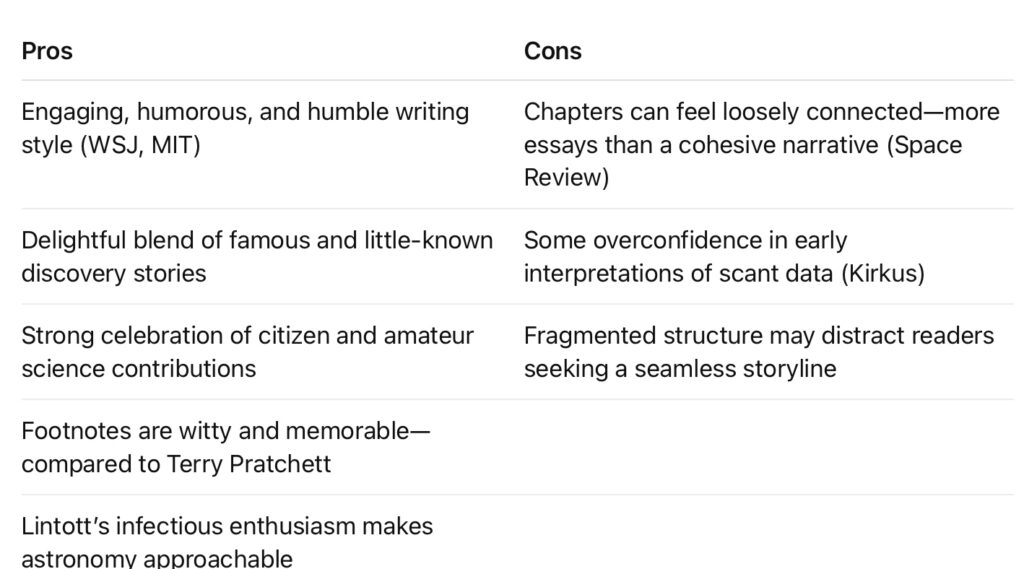
Recommended if you enjoy:
- Engaging narratives that mix personal storytelling and science.
- Learning about unexpected scientific discoveries.
- Appreciating the role of amateurs in professional science.
Considerations:
- If you prefer strongly woven narratives or in-depth analysis, this book reads more like thematic essays.
- Occasional presentation of early scientific interpretations without extensive critique may feel simplistic to some.
Overall, Accidental Astronomy is praised for its readability, humor, and celebration of serendipity—but readers looking for a tightly structured book with heavy scientific scrutiny might find it a bit scattered.
Ancient Genes, Modern Lives: How Evolution Still Shapes Us
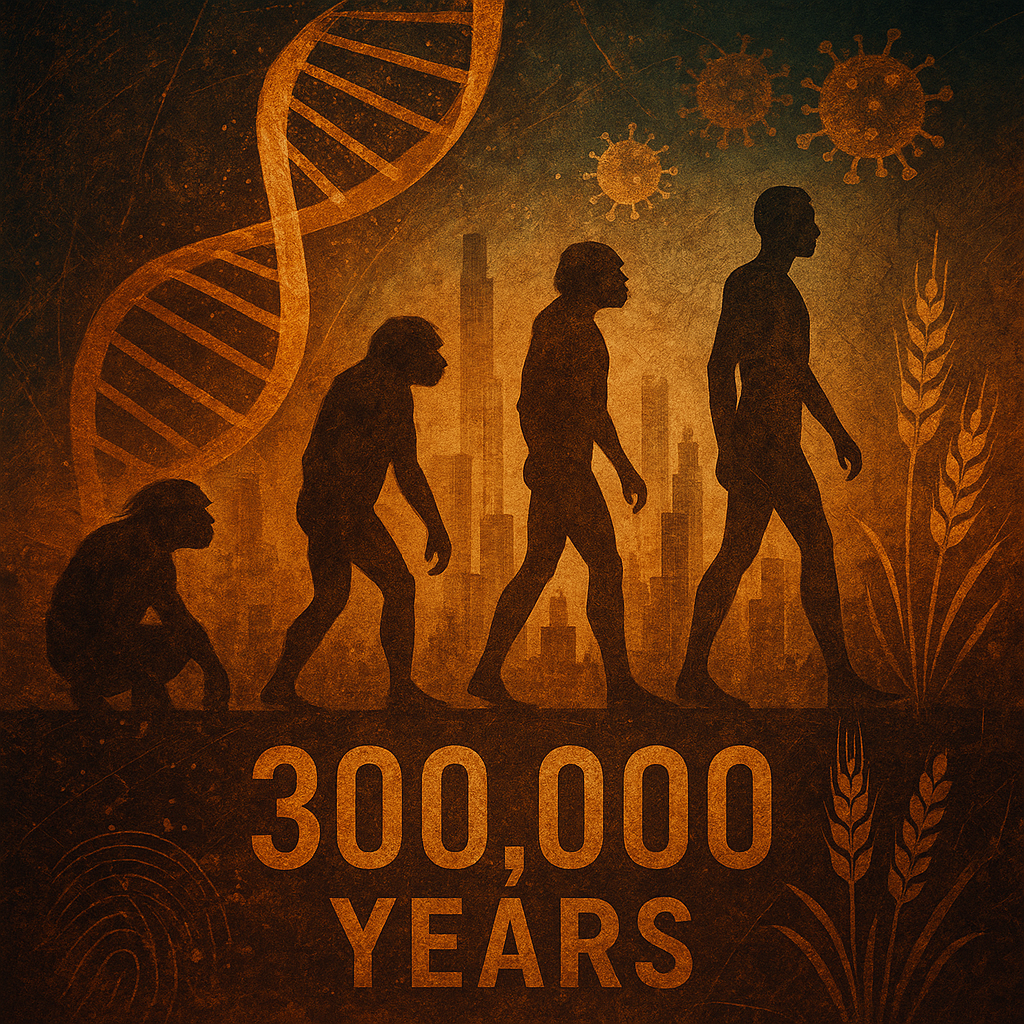
ChatGPT:
⸻
🧬 A 300,000-Year Evolutionary Odyssey of Homo Sapiens
This extended summary delves deeply into Professor Robin May’s lecture tracing the genetic journey of Homo sapiens from our origin in Africa to our modern health issues shaped by ancient adaptations. The lecture connects the dots between fossil records, genome sequencing, pandemics, and societal shifts such as agriculture to explore how evolutionary pressures continue to impact us today.
⸻
🌍 Origins and Early Human Evolution
Anatomically modern humans (Homo sapiens) evolved around 300,000 years ago in Africa. Like all species, humans were shaped by evolutionary forces like natural selection, genetic drift, and mutation. Traits that improved reproductive success tended to persist, while harmful ones faded. But our understanding of these forces remained speculative until recently.
The turning point came with whole genome sequencing and palaeontological discoveries. These breakthroughs allowed scientists to trace how ancestral genetic variants were selected over millennia, and surprisingly, how they still influence modern health.
⸻
🧬 Neanderthal and Denisovan DNA: Our Interbreeding Past
In the last decade, genome sequencing revealed Homo sapiens interbred with Neanderthals and a mysterious lineage called Denisovans. This process, called introgression, introduced foreign genes into the modern human gene pool.
• 2% of modern Eurasian genomes consist of Neanderthal DNA.
• Some Neanderthal genes conferred survival advantages, such as better immune responses.
• Others were detrimental and gradually disappeared from the gene pool.
This randomness of inheritance is not completely random—it reflects evolutionary forces that favor certain traits and purge others.
⸻
🗣️ FoxP2 Gene and Language Evolution
A striking example of negative selection is the FoxP2 gene, crucial for language acquisition and vocalization.
• Found on chromosome 7, this gene shows a complete absence of Neanderthal versions in modern humans.
• This suggests that Neanderthal variants likely impaired communication, which posed a major reproductive disadvantage.
Language is central to survival in human societies—those lacking effective communication were less likely to thrive or reproduce.
⸻
🦠 Neanderthal Genes and Viral Immunity
Conversely, positive selection preserved certain Neanderthal genes:
• On chromosome 12, Neanderthal variants of the OAS1, OAS2, and OAS3 genes help trigger stronger immune responses.
• These versions offered protection against West Nile virus, Hepatitis C, and, notably, Covid-19.
• People with these versions of OAS3 had a lower risk of severe Covid symptoms, showing how ancient adaptations continue to benefit us.
This remarkable insight links prehistoric gene flow directly to 21st-century public health outcomes.
⸻
🌾 The Agricultural Revolution and Its Costs
Roughly 10,000–12,000 years ago, human societies shifted from nomadic hunter-gatherers to settled agriculturalists. Agriculture independently arose in:
• The Fertile Crescent (Iraq, Israel, Turkey)
• Parts of Asia and the Americas
This transition had massive consequences:
• Reduced dietary diversity led to micronutrient deficiencies.
• Domesticated livestock introduced new zoonotic diseases.
• Villages and cities encouraged pathogen spread.
These challenges triggered new selective pressures on the human genome.
⸻
🍄 OCTN1 and Ergothioneine Uptake
One genetic adaptation to this new lifestyle is the OCTN1 gene, which assists in absorbing ergothioneine, a rare but essential nutrient:
• Ergothioneine is found only in certain fungi and microbes—not made by humans.
• The agricultural diet lacked it, so individuals with a variant that increased OCTN1 expression absorbed more and survived better.
• As a result, this variant became common in modern populations.
This is a textbook example of how a nutritional bottleneck drove genetic evolution.
⸻
☠️ The Black Death and Immune Evolution
Some evolutionary changes occurred over much shorter timelines. The bubonic plague, caused by Yersinia pestis, left catastrophic imprints on human genetics:
• The Plague of Justinian (541 CE) killed ~25% of Mediterranean populations.
• The Black Death (1348–1350) killed 30–60% of Europeans.
Such dramatic mortality exerted extreme selection pressure:
• Survivors often had gene variants that enhanced immune activity.
• Gene families like TLR, MHC, and ERAP surged in frequency.
• However, hyperactive immune systems today correlate with autoimmune diseases like rheumatoid arthritis.
This is a clear case of evolutionary trade-offs: past benefits come at modern costs.
⸻
🧠 The Genetic Lottery: Winners and Losers
Our genomes show a patchwork of “winning” and “losing” genes from Neanderthal and Denisovan introgression:
• “Genomic deserts” lack archaic DNA—often because those regions conferred disadvantages.
• “Genomic enrichments” show retained segments with proven adaptive value.
Thus, evolution isn’t just about survival, but the fitness and reproductive success of specific traits in specific environments.
⸻
🧪 Modern Health: A Legacy of Ancient Evolution
The most compelling message from the lecture is that many contemporary health issues are echoes of ancient adaptations:
• Immune system traits shaped by plagues now fuel autoimmunity.
• Nutritional strategies evolved for early farming are now mismatched with modern diets.
• Some genes from extinct relatives protect us today; others would have hindered us.
Understanding this helps frame modern medicine within a long evolutionary continuum.
⸻
🔚 Final Thoughts
Robin May’s lecture reframes how we view genetics, pandemics, agriculture, and human health. It reveals how deep-time biological events ripple forward, influencing everything from disease susceptibility to dietary needs. Our evolutionary story is ongoing, written into our DNA, with new chapters unfolding as environments, pathogens, and lifestyles change.
Hope in the Dark

Let There Always Be Light
(Searching for Dark Matter) For this we go out dark nights, searching For the dimmest stars, For signs of unseen things: To weigh us down. To stop the universe From rushing on and on Into its own beyond Till it exhausts itself and lies down cold, Its last star going out. Whatever they turn out to be, Let there be swarms of them, Enough for immortality, Always a star where we can warm ourselves. Let there even be enough to bring it back From its own edges, To bring us all so close that we ignite The bright spark of resurrection.
ChatGPT:
Interpretation & Commentary
1.
Astronomical longing as a metaphor
The poem starts with stargazing—“searching / For the dimmest stars, / For signs of unseen things.” On the surface, it’s about scientists hunting for dark matter. But on a deeper level, it reflects a human yearning: we peer into the void, hoping to uncover hidden forces that give meaning and structure to our lives.
2.
Fear of cosmic silence
Lines like “To weigh us down. To stop the universe… Till it exhausts itself and lies down cold” express existential dread—the universe’s eventual heat death. Elson asks: can even the universe tire out? Are we alone in its vast emptiness, hurtling toward oblivion?
3.
Hope in abundance
“Whatever they turn out to be, / Let there be swarms of them, / Enough for immortality” – here, dark matter becomes a symbol of potential salvation. We hope there’s so much of it that there’s always some place to “warm ourselves” under a glowing star—a refuge against cosmic indifference.
4.
Resurrection and renewal
The most powerful image: “Let there even be enough to bring it back / From its own edges… The bright spark of resurrection.” It’s a reversal of entropy—dark matter not just sustaining but reviving. It’s a wish for revival that goes beyond stars—resurrecting the universe itself, maybe even us.
Key Themes
- Scientific awe meets philosophical wonder: The poem blends astrophysical curiosity with metaphysical longing. Dark matter becomes a symbol for hope.
- Cosmic mortality: There’s a palpable fear of meaninglessness if the universe ends, but also the audacity to imagine renewal.
- Spiritual resonance: It’s less about data and more about the human drive to believe in something unseen that gives us meaning.
Why it matters
Rebecca Elson was both an astronomer and a poet. Her unique perspective lets her weave scientific reality (the hunt for dark matter) with spiritual yearning (resurrection, immortality) in a single breath. It feels like science becomes prayer.
Final thoughts
Elson doesn’t just want us to understand dark matter—she wants us to long for it. To care about something invisible yet fundamental. The poem quietly dares: maybe the universe’s hidden substance is also the substance of our hope.
I.
THE POEM’S CONCEPT, PHILOSOPHICALLY SPEAKING
Elson’s poem is about:
- Dark matter as the unknown substance holding the universe together.
- The fear of universal death via entropy and heat death.
- A wish for cosmic abundance, not just survival, but resurrection.
- Human participation in the act of understanding and preserving reality.
In other words, it’s a poetic blend of existentialism, cosmic pessimism, Platonic idealism, and a pinch of theodicy. Yes, all of it, in 20 lines. She’s ambitious like that.
II.
COMPARISONS IN PHILOSOPHY
1.
Pascal’s Wager & Cosmic Humility
Blaise Pascal, in his Pensées, writes of the “infinite spaces” that terrify him—he’s gripped by the sheer indifference of the cosmos. Elson, however, counters that terror by pleading for hope within those infinite spaces. Where Pascal is paralyzed by the void, Elson walks into it with a telescope and a hopeful shrug.
Pascal: “The silence of these infinite spaces frightens me.”
Elson: “Let there be enough to bring [the universe] back… the bright spark of resurrection.”
Big difference in vibes. One hides from the abyss. The other sends it a love letter.
2.
Nietzsche and the Eternal Return
Elson’s poem references entropy, death, and cosmic exhaustion—but she wishes for resurrection, not repetition. Compare that to Nietzsche’s Eternal Return—the idea that life, and the universe, endlessly recycles itself.
But Elson doesn’t accept repetition; she yearns for transcendence. Nietzsche wants you to say “yes” to living the same life forever. Elson wants the universe to get a second chance better than the first.
So:
Nietzsche: “Love your fate, it comes back around.”
Elson: “Actually, could fate bring more light next time? Maybe not die so fast?”
3.
Spinoza and Substance
In Spinoza’s monism, all reality is one substance: God or Nature. It’s indivisible, self-caused, and infinite. Elson’s fascination with dark matter as the invisible scaffold of the cosmos echoes Spinoza’s idea of a hidden substance behind appearances.
Her poetic wish that “there be swarms of them…enough for immortality” resembles Spinoza’s idea of divine plenitude—an abundance of being that sustains everything.
But where Spinoza’s substance is rational and necessary, Elson’s dark matter is mysterious and fragile. Spinoza is geometry; Elson is vulnerability.
4.
Heidegger and the Question of Being
Martin Heidegger, the rain cloud of 20th-century thought, talks about being-toward-death and Dasein (human existence as awareness of being). Elson’s poem hums with the Heideggerian theme of confronting non-being (cosmic death) while reaching for meaning.
But instead of Heidegger’s brooding alienation, Elson offers a scientifically flavored faith: maybe meaning is out there in the unseen, unmeasured parts of the cosmos. Maybe existence is scaffolded by mystery.
So Elson takes Heidegger’s question—why is there something rather than nothing?—and turns it into:
Can we find enough of that something to make the nothing go away?
5.
Teilhard de Chardin & the Omega Point
Oh boy. Teilhard, the Catholic mystic and paleontologist, imagined the Omega Point: a final convergence of consciousness, science, and spirit at the end of time. Elson, though not religious, dreams of something similar: the idea that the universe might revive itself through its hidden contents.
Both are whispering: maybe the cosmos isn’t winding down—maybe it’s winding up toward something miraculous.
III.
EXAMPLES FROM LITERATURE & ART
- Italo Calvino’s Cosmicomics: Fictional tales that use astrophysical phenomena as metaphors for love, loss, and meaning. Elson would fit right in.
- Rainer Maria Rilke: “You must give birth to your images.” Elson is birthing images of unseen matter as faith made visible.
- Carl Sagan, oddly enough: “We are a way for the universe to know itself.” Elson: “We are a way for the universe to save itself, maybe.”
IV.
SO WHAT?
The poem takes dark matter—a literal scientific mystery—and turns it into a metaphysical lifeline. In doing so, it brushes shoulders with centuries of philosophy:
- The invisible as necessary (Plato, Spinoza)
- The cosmos as a stage for existential drama (Pascal, Heidegger)
- The yearning for transcendence over finality (Nietzsche, Teilhard)
It’s a scientific prayer written by someone who lived in the tension between cold data and warm hope. A cosmic whisper: maybe the universe hasn’t given up on us yet.

Neurons in the Courtroom

ChatGPT:
Brain Sciences for Lawyers, Judges, and Policymakers
This book explores how neuroscience intersects with the legal system, influencing the roles of lawyers, judges, and policymakers. Anthony Wagner provides a multidisciplinary guide to responsibly integrating brain science into legal reasoning, criminal justice, and public policy.
Conclusion
The book underscores both the potential and the pitfalls of incorporating neuroscience into the legal domain. Wagner emphasizes that brain imaging and cognitive neuroscience can inform judgments about mental states, memory, and behavior, but warns against over-reliance on these tools due to interpretive limitations and ethical concerns. Legal actors must understand the scientific foundations, apply rigorous evidentiary standards, and avoid misleading uses in the courtroom. The author advocates for professional guidelines, cross-disciplinary training, and transparent procedures for the responsible use of neuroevidence. Ultimately, neuroscience should serve justice—not undermine it.
Key points
🧠 Scientific validity: Brain imaging (like fMRI) reveals useful patterns but cannot definitively establish intent or truthfulness.
⚖️ Legal thresholds: Courts must assess the relevance and reliability of neuroscience evidence under existing legal standards.
📉 Misinterpretation risk: Non-expert audiences may misread colorful brain scans as conclusive proof; expert interpretation is essential.
🔐 Privacy issues: Neurodata involves intimate mental information, raising deep concerns about consent and surveillance.
📈 Policy insights: Neuroscience can inform criminal rehabilitation, juvenile justice, and educational interventions—but only with caution.
👥 Cross-disciplinary training: Legal professionals must gain basic neuroscience literacy to responsibly engage with neuroevidence.
📚 Real case studies: The book examines legal cases where neuroscience played a role in determining guilt, capacity, or sentencing.
🎯 Ethical safeguards: Wagner calls for new guidelines to govern the admissibility and ethical use of neuroscience in courts.
🔄 Dynamic legal adaptation: Legal doctrines must evolve as brain science advances—but remain grounded in rights and due process.
📌 Public education: Broader understanding of neuroscience’s limits is needed to prevent misuse or overhyping in media and courts.
Summary
Future Challenges and Recommendations: Concludes with a call for legal reforms, ethical frameworks, and public understanding as neuroscience’s role grows.
Introduction to Neuroscience in Law: Wagner sets the stage by explaining why legal professionals should care about brain science and how it may influence justice.
The Science of Brain Imaging: The book details how fMRI, EEG, and other tools work, what they can and can’t show, and their evidentiary limitations.
Legal Standards for Expert Testimony: Wagner reviews Daubert and Frye standards, outlining when and how neuroevidence is admissible.
Memory and Deception Detection: He analyzes how neuroscience has been used to assess memory accuracy and detect deception in suspects and witnesses.
Responsibility and Mental State: The author delves into how neuroscience contributes to understanding mental illness, criminal intent, and culpability.
Ethical and Privacy Concerns: A core focus is the protection of mental privacy and autonomy when dealing with neural data.
Implications for Juvenile and Preventative Justice: Wagner explores how brain science affects views on adolescent responsibility and the design of rehabilitation programs.
Policy Design and Neuroscience: The book argues for evidence-based policies that consider developmental neuroscience in education and criminal justice.
Institutional Preparedness: Wagner stresses the need for institutional training and interdisciplinary collaboration to navigate emerging science responsibly.
What is
Brain Sciences for Lawyers, Judges, and Policymakers
about?
It’s a comprehensive guide that explores how neuroscience intersects with legal systems. The book explains how brain science, including neuroimaging and cognitive studies, can inform legal decisions, influence public policy, and pose ethical challenges.
Who is the author of the book?
The book is written by Anthony Wagner, a renowned cognitive neuroscientist, known for his work on memory and decision-making. He brings scientific rigor and accessibility to legal audiences.
Why should legal professionals learn about neuroscience?
Because neuroscience is increasingly used in courtrooms to assess memory, mental states, and behavior. Understanding its capabilities and limits helps ensure fair, ethical use of such evidence in legal processes.
What legal standards are discussed for admitting neuroscience evidence?
The book examines Daubert and Frye standards—two major frameworks used by courts to assess the admissibility of expert scientific testimony, focusing on reliability and general acceptance.
Is brain imaging (like fMRI) reliable in court?
It can offer insights but is not definitive proof of thoughts, intent, or truthfulness. The book warns against over-reliance and encourages cautious interpretation supported by expert testimony.
What are the ethical risks of using neuroevidence?
Ethical concerns include mental privacy, lack of informed consent, and the potential misuse of brain data in employment, insurance, or criminal contexts. The book advocates for robust safeguards.
How does neuroscience affect juvenile justice?
The book shows that adolescent brain development affects decision-making and responsibility. Neuroscience has influenced rulings against extreme sentences for minors and supports rehabilitation-focused approaches.
Can neuroscience be used to detect lies or false memories?
Not reliably. Wagner explains that while brain patterns can suggest certain mental states, they can’t conclusively prove deception or the truthfulness of memories due to overlap and variability.
What does the book suggest for policymakers?
It calls for interdisciplinary training, scientific advisory bodies, and evidence-based lawmaking. Policymakers should use neuroscience to improve justice and health systems—cautiously and ethically.
How does the book propose to handle neurodata privacy?
Wagner recommends clear legal protections for neurodata, comparing it to bodily autonomy. He supports legislation ensuring informed consent, limited access, and secure data handling procedures.
Tricked by Our Brain: The Finance Trap

ChatGPT:
Blind Spots & Bad Decisions: Why We Fall for Financial Traps
This lecture by Professor Raghavendra Rau (Cambridge University) explores the psychological traps that cause individuals to make poor financial decisions. Drawing from behavioral finance, it outlines how belief and preference biases distort our judgment and leave us vulnerable to exploitation by financial professionals.
Conclusion
The lecture reveals how our minds, not just external forces, contribute to financial missteps. We’re overconfident, misinterpret information, frame risks irrationally, and treat all money unequally. This not only leads to suboptimal decisions but also enables financial actors to manipulate us more easily. For instance, overconfidence leads to excessive trading; anchoring distorts stock valuation; loss aversion leads to poor timing; and mental accounting encourages irrational spending. The lecture links these psychological patterns with agency conflicts, highlighting how advisors can exploit biases like framing or loss aversion for gain. Social dynamics—such as obedience to authority, conformity, and the desire to avoid conflict—worsen our inaction. To counter these effects, the next lecture promises strategies rooted in behavioral insights to help align decisions with our true financial goals.
Key points
🧠 Overconfidence bias: Leads individuals to overtrade, ignore professional advice, and underperform in the market.
🔗 Anchoring effect: Irrelevant numbers, like past purchase prices or Social Security digits, skew decision-making.
📈 Confirmation bias: People seek information that confirms pre-existing beliefs, especially harmful in investing.
🔥 Loss aversion: We feel losses twice as strongly as gains, leading to irrational avoidance of selling losing assets.
💸 Mental accounting: Individuals treat money differently based on source or label, which leads to poor budgeting.
🎯 Narrow framing: Evaluating decisions in isolation prevents seeing long-term portfolio benefits, reducing diversification.
🌍 Ambiguity aversion: People avoid unfamiliar investments due to unknown risks, missing out on global opportunities.
🎭 Framing manipulation: Financial products are marketed with euphemisms like “principal protected” to exploit emotions.
👥 Social pressures: Conformity and obedience to authority deter people from questioning advisors or complex products.
🛑 Self-serving bias: Investors rationalize bad decisions to maintain self-image, exacerbating cognitive blind spots.
Summary
Social and emotional barriers persist: Self-image protection, conformity, and authority deference prevent consumers from challenging poor financial advice or complex fee structures.
Finance assumes rationality: Traditional financial theories depend on the idea of consistent, logical decision-making. But real-world behavior often strays from these ideals due to cognitive biases.
Belief biases distort judgment: People are overconfident in their abilities, prone to seeing patterns that don’t exist, and tend to misinterpret financial data through representativeness and availability.
Anchoring traps us: Decisions are often rooted in irrelevant reference points, like purchase prices or suggested values, which leads to irrational holding or selling behaviors.
Confirmation bias fuels echo chambers: Once we adopt a belief, we selectively accept supportive evidence and ignore contradictory facts—intensified by personalized newsfeeds and social media.
Loss aversion shapes risk behavior: People require disproportionately high potential gains to take risks equivalent to small losses, leading to risk-averse behavior that impairs returns.
Mental accounting is irrational: We treat money from bonuses, gifts, or inheritances differently than earned income, leading to inconsistent spending and investing decisions.
Narrow framing limits perspective: Investors focus on individual choices rather than holistic portfolio outcomes, causing them to avoid beneficial diversification or rebalancing.
Familiarity beats uncertainty: Home bias and reluctance to explore new financial products arise from a discomfort with ambiguity, not from objective risk analysis.
Biases empower exploitation: Financial advisors and product designers exploit known behavioral patterns (like framing and fear of loss) to sell high-commission products.
Quotes from “Blind Spots & Bad Decisions” by Raghavendra Rau
🎓 On the illusion of logic in finance
“We like to think we make financial decisions logically… But in reality, we’re often our own worst enemies.”
📉 On overconfidence and market damage
“Investors who traded more frequently actually earned lower returns… because they were too confident in their ability to time the market or pick winners.”
🧠 On anchoring bias
“You fixate on a number—like your purchase price—even though it has no bearing on what the stock is worth today.”
🔄 On the echo chamber of confirmation bias
“Before long, you’re in an echo chamber, surrounded by information that confirms what you already believed.”
💔 On loss aversion
“Psychologically, losses hurt about twice as much as equivalent gains feel good.”
🎰 On mental accounting
“You’re likely to treat it as ‘fun money’… even though it’s exactly the same in financial terms.”
🔍 On narrow framing and investment reluctance
“Because most people focus on each bet in isolation, they reject it.”
🌐 On ambiguity aversion
“We prefer known risks over unknown ones—even when the unknown might be favorable.”
📦 On how advisors exploit biases
“A clever one, who’s not acting in your best interest, will exploit that confidence to upsell you… that generate high commissions.”
🎭 On framing manipulations
“A structured note might be advertised as ‘principal protected,’ even though the fine print reveals significant risks.”
🤫 On why people stay silent
“It’s awkward to ask someone, especially a long-time advisor, ‘Are you really acting in my best interest?’ So we stay quiet.”
🧩 On self-deception
“We’re not just misled by others — we’re primed to mislead ourselves.”
📚 On the role of behavioral finance
“It doesn’t just explain our mistakes. It helps us understand why those mistakes are so easy to exploit.”
💡 On the path forward
“With the right tools, we can learn to outsmart the system—and even outsmart ourselves.”
FAQs
What is the main message of Raghavendra Rau’s lecture?
The lecture highlights how human psychology—through cognitive and emotional biases—leads to poor financial decisions, even when we have sufficient information. These blind spots not only cause mistakes but also make individuals more susceptible to financial manipulation.
What are belief biases?
Belief biases distort how we interpret financial information. Examples include overconfidence, anchoring, representativeness, and confirmation bias. These cause people to misjudge risks, misread patterns, and overestimate their own knowledge.
What are preference biases?
Preference biases influence how we feel about outcomes. They include loss aversion, mental accounting, narrow framing, and ambiguity aversion. These cause people to make irrational choices based on emotional discomfort rather than logic.
Why is loss aversion so important in finance?
Loss aversion means we feel the pain of losses more intensely than the pleasure of gains—often twice as much. This can lead to holding onto bad investments too long, selling winners too early, or avoiding rational risks.
How do financial professionals exploit these biases?
Advisors may use framing tricks (e.g., calling something “principal protected”), exploit mental accounting, or rely on a client’s loss aversion or overconfidence to push high-fee or suboptimal products.
What is the role of framing in financial decisions?
Framing alters how choices are presented to influence decisions. For instance, a product described as offering a “bonus” may seem more attractive than one described as giving a “rebate,” even if the monetary value is the same.
How does overconfidence harm investors?
Overconfident investors trade too frequently, believing they can beat the market. This behavior typically results in lower returns due to transaction costs and poor timing.
What is mental accounting and why is it problematic?
Mental accounting involves treating money differently based on arbitrary labels, such as “bonus” vs. “salary.” It leads to inconsistent financial behavior and suboptimal decisions, like overspending windfalls.
How do social dynamics worsen financial mistakes?
People often conform to group behavior or defer to authority figures, avoiding confrontation or hard questions even when they suspect bad advice. This allows poor practices to persist unchallenged.
Can we overcome these biases?
Yes. While the biases are hardwired, awareness and the use of structured systems, default options, and better-designed environments can help individuals make better financial decisions over time.
